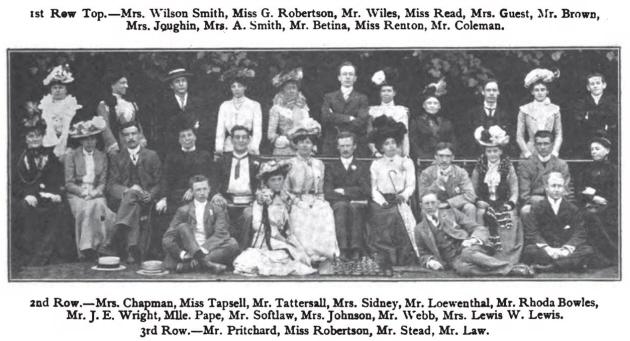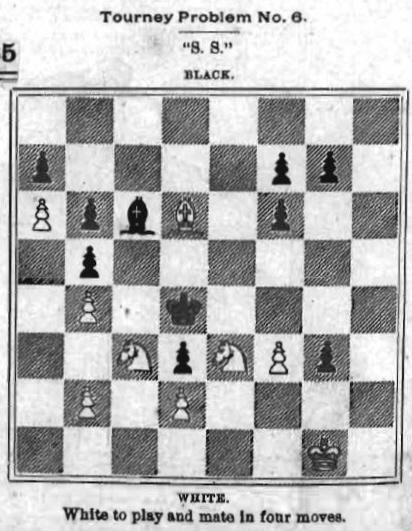Chess Notes
Edward Winter
When contacting us by e-mail, correspondents are asked to include their name and full postal address and, when providing information, to quote exact book and magazine sources. The word ‘chess’ needs to appear in the subject-line or in the message itself.
| First column | << previous | Archives [90] | next >> | Current column |
7430. High Life
Wanted: information about this picture, which was published on page 42 of the May 1992 issue of the British Airways magazine High Life:
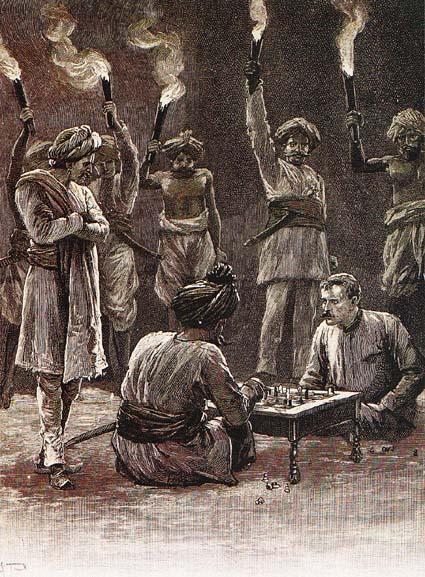
7431. MacDonnell v Boden
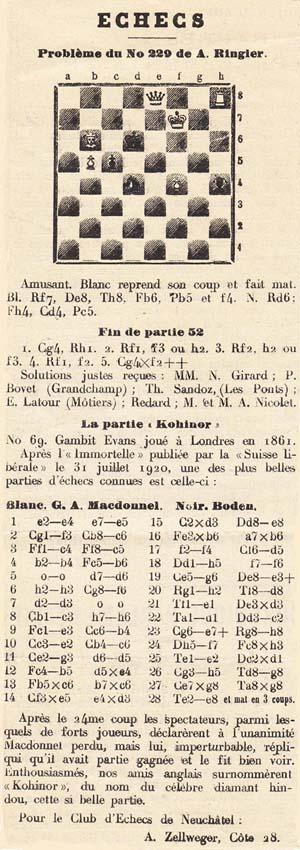
This cutting in our collection is unidentified, but we believe that it comes from an issue of the Suisse Libérale on or around 8 December 1923. Alfred Zellweger described the MacDonnell v Boden encounter as ‘une des plus belles parties d’échecs connues’. That may be considered an exaggeration, but other writers have also stated that the game was regarded as the Kohinor (a word spelt various ways) of chess. See, for instance, pages 48-49 of The Golden Treasury of Chess by Francis J. Wellmuth (Philadelphia, 1943).
MacDonnell gave the game pride of place between the Preface and Contents pages of his book The Knights and Kings of Chess (London, 1894), stating that it had lasted only 15 minutes:
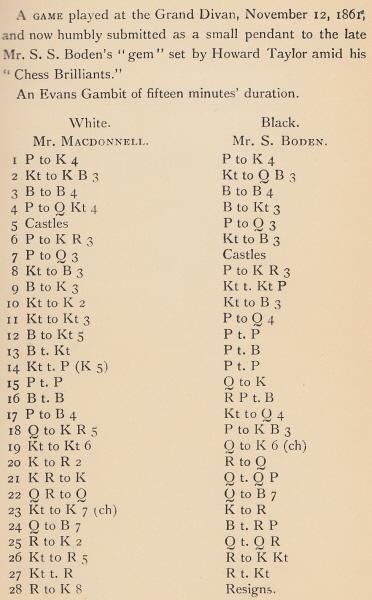
Boden’s ‘gem’ in I.O. Howard Taylor’s book was the 20...Qxf3 game discussed in C.N. 7406.
MacDonnell’s ‘Kohinor’ victory was published on pages 23-24 of the 1862 Chess Player’s Chronicle, with his opponent identified only as ‘Mr -, one of the best players in England’ and with a single note:
1 e4 e5 2 Nf3 Nc6 3 Bc4 Bc5 4 b4 Bb6 5 O-O d6 6 h3 Nf6 7 d3 O-O 8 Nc3 h6 9 Be3 Nxb4 10 Ne2 Nc6 11 Ng3 d5 12 Bb5 dxe4 13 Bxc6 bxc6 14 Nxe5 exd3 15 cxd3 Qe8 16 Bxb6 axb6 17 f4 Nd5 18 Qh5 f6 19 Ng6 Qe3+ 20 Kh2 Rd8 21 Rfe1 Qxd3 22 Rad1 Qc2 23 Ne7+ Kh8 24 Qf7 Bxh3
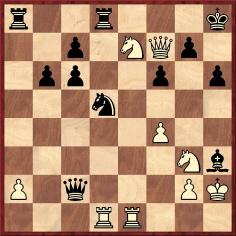
‘Here Black and all the bystanders, some first-rate amateurs, pronounced White’s game to be hopeless; to which White replied that he had a forced won game, and proved it by playing thus:’
25 Re2 Qxd1 26 Nh5 Rg8 27 Nxg8 Rxg8 28 Re8 Resigns.
7432. The illusion of equality
‘... a good attacking player who allows the game to simplify usually has in mind some ultimate movement which destroys the illusion of equality.’
Source: Test Your Chess by Gerald Abrahams (London, 1963), page 92.
7433. Forgotten brilliancy
Eduardo Bauzá Mercére (New York, NY, USA) sends this cutting from Hermann Helms’ column in the Brooklyn Daily Eagle of 2 June 1932, page 28:
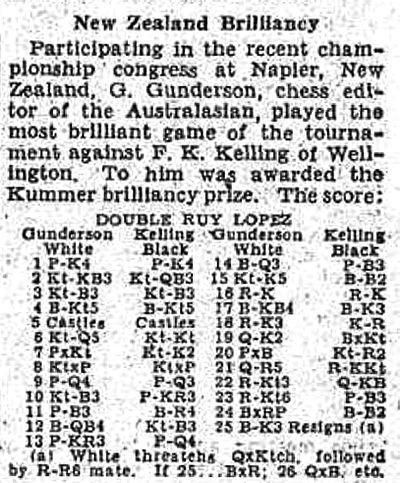
Gunnar Gundersen – Fedor K. Kelling
New Zealand Championship, Napier, 1931-32
Four Knights’ Game
1 e4 e5 2 Nf3 Nc6 3 Nc3 Nf6 4 Bb5 Bb4 5 O-O O-O 6 Nd5 Nxd5 7 exd5 Ne7 8 Nxe5 Nxd5 9 d4 d6 10 Nf3 h6 11 c3 Ba5 12 Bc4 Nf6 13 h3 d5 14 Bd3 c6 15 Ne5 Bc7 16 Re1 Re8 17 Bf4 Be6 18 Re3 Kh8 19 Qe2 Bxe5 20 dxe5 Nh7 21 Qh5 Rg8 22 Rg3 Qf8
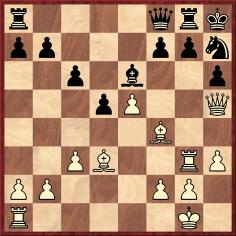
23 Rg6 f6 24 Bxh6 Bf7 25 Be3 Resigns.
Helms misspelled White’s name, and in his note 26 QxB should be 26 BxB.
7434. Anthony Andrews
Below is part of a photograph which appeared in an article about the British actor Anthony Andrews on pages 56-58 of the Observer Magazine, 13 December 1981:
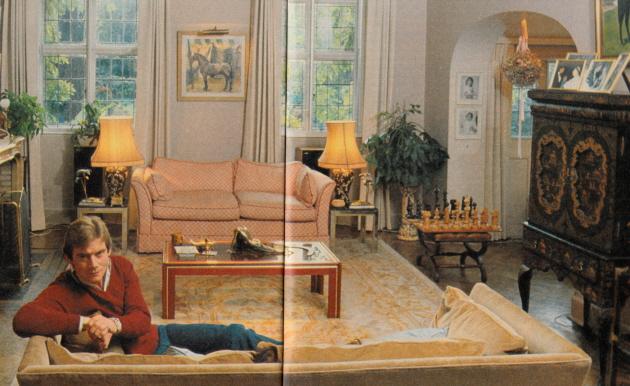
From page 58:
‘The chess set, which he found in a shop in York while filming Brideshead Revisited, was a Christmas present for his nine-year-old son Joshua. “I bought it because it has the largest chess pieces I have ever seen”, he says. “Joshua is a kind of genius at chess and licks me every time we play.’”
7435. Knight promotions (C.N. 7418)
Steven B. Dowd (Birmingham, AL, USA) notes that the knight promotion motif was used in a composition by Donald H. Hersom in the 10/1936 Fairy Chess Review. It can be found online by copying PROBID='P0553007' into the search-box of the Schwalbe website.
7436. Réti v Alekhine, Baden-Baden, 1925
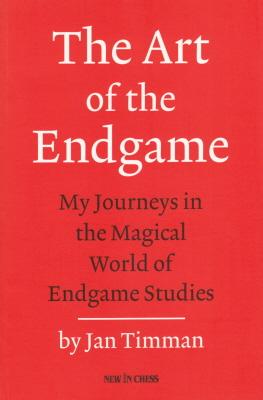
From page 7 of Timman’s The Art of the Endgame (C.N. 7418):
‘The world of chess was the most fascinating. I devoured Euwe’s books. The memory of the game Réti-Alekhine, annotated in his book Practical Chess Lessons, which never ceased to amaze me: the black rook appearing on e3 and remaining en prise there for several moves.’
C.N.s 5632 and 6358 discussed the unresolved matter of the contradictory versions of the game-score:
A) 18 Bg2 Bh3 19 Bf3 Bg4 20 Bg2 Bh3 21 Bf3 Bg4 22 Bh1 h5;
B) 18 Bg2 Bh3 19 Bf3 Bg4 20 Bh1 h5;
C) 18 Bh1 h5.
In other words, it is currently unknown whether the game ended with 42...Nd4, 40...Nd4 or 38...Nd4.
Jean-Pierre Rhéaume (Montreal, Canada) notes that version B was given on pages 653-654 of 500 Master Games of Chess by S. Tartakower and J. du Mont (London, 1952). We add that it was also version B that Tartakower annotated on pages 97-99 of his book Schachmethodik (Berlin, 1928 and 1929).
7437. 1 d4 d5 2 e3 (C.N.s 7334 & 7340)
Concerning the term Biscay Opening, the following comes from page 107 of Ideas modernas en las aperturas de ajedrez by S. Tartakower (fifth edition, Buenos Aires, 1967):
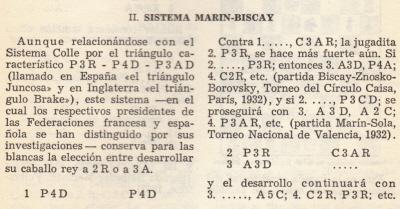
7438. High Life (C.N. 7430)

Pete Klimek (Berkeley, CA, USA) reports that this was an illustration in ‘The Black Knight’, a story by Raymund Allen in volume three of The Strand Magazine, 1892.
7439. Huxley St John Brooks (C.N.s 3417 & 7012)
Some comic verse, ‘Kann That Caro’, from page 171 of the November 1932 American Chess Bulletin:
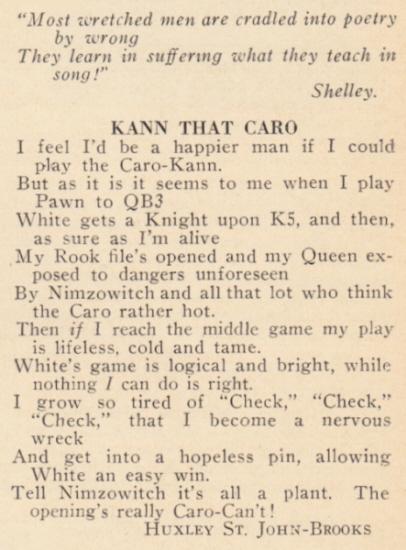
7440. Counter-attack (C.N.s 5090, 5148 & 5545)
On page 217 of Der Weg zur Meisterschaft (Leipzig, 1913) Franz Gutmayer attributed the maxim ‘Counter-attack is the best defence’ to Anderssen, but on what basis?
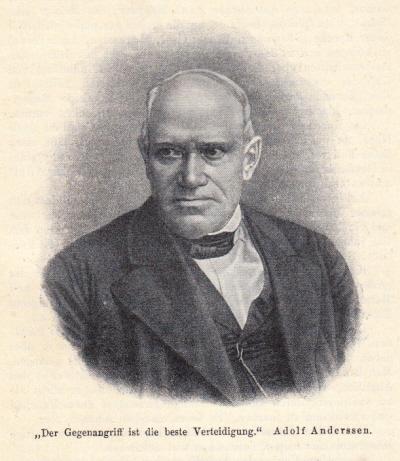
7441. Cartoons
C.N. 5897 gave this cartoon from page 33 of the Chess Weekly, 26 June 1909:
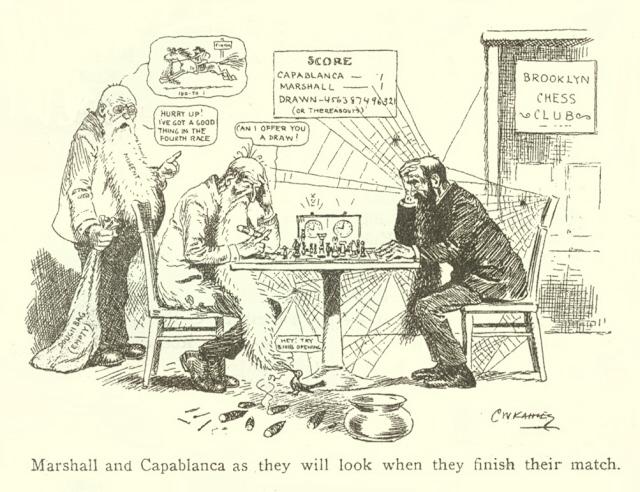
With regard to fears that the 1927 world championship match might drag on forever (‘s’éterniser’) V. Soultanbéieff wrote in a footnote on page 18 of Le match Capablanca Alekhine (published by L’Echiquier in Brussels in 1929):
‘Une caricature spirituelle parue dans la Haagsche Post exprima cette idée d’une façon plaisante. Elle avait pour titre “Le match Capablanca-Alekhine”; la 986e partie est déclarée nulle et elle représentait les deux joueurs – vieillards infirmes et barbus – jouant la partie en 1957 ...’
Can that cartoon be traced?
In the meantime, we recall the following from page 122 of the April-May 1910 Wiener Schachzeitung:
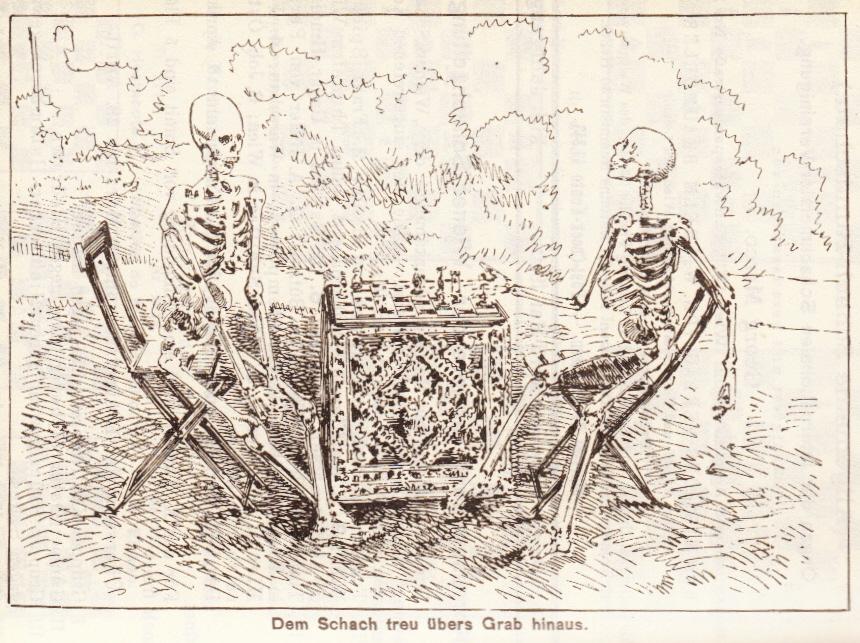
7442. Capablanca v Alekhine and 5-5
We continue to seek citations in support or denial of the claim that the 1927 world championship match would have been drawn if a score of 5-5 had been reached. See Capablanca v Alekhine, 1927.
Claus van de Vlierd (Oldenburg, Germany) draws attention to page 125 of Match Alekhin-Kapablanka na pervenstvo mira by G. Levenfish and P. Romanovsky (Leningrad, 1928):
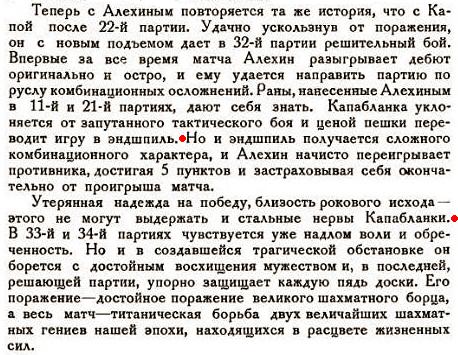
The marked passage, concerning the 32nd match-game, is given below in an English translation by Dan Scoones (Victoria, BC, Canada):
‘However, the endgame also proved to be of a complicated, combinational character, and Alekhine completely outplayed his opponent, attaining the score of five points and conclusively insuring himself against the loss of the match.
Even Capablanca’s nerves of steel could not withstand the vanished hope of victory and the proximity of a fatal result.’
7443. Shakespeare
Further to a tip-off from Ross Jackson (Raumati South, New Zealand) we have been reading ‘False Play: Shakespeare and Chess’ by William Poole on pages 50-70 of the Spring 2004 Shakespeare Quarterly.
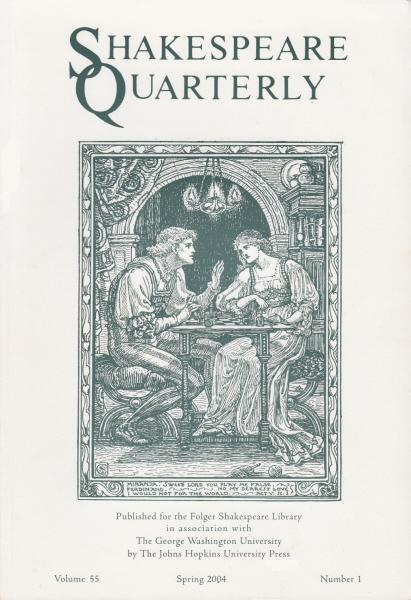
With Dr Poole’s kind permission, a page is shown here:
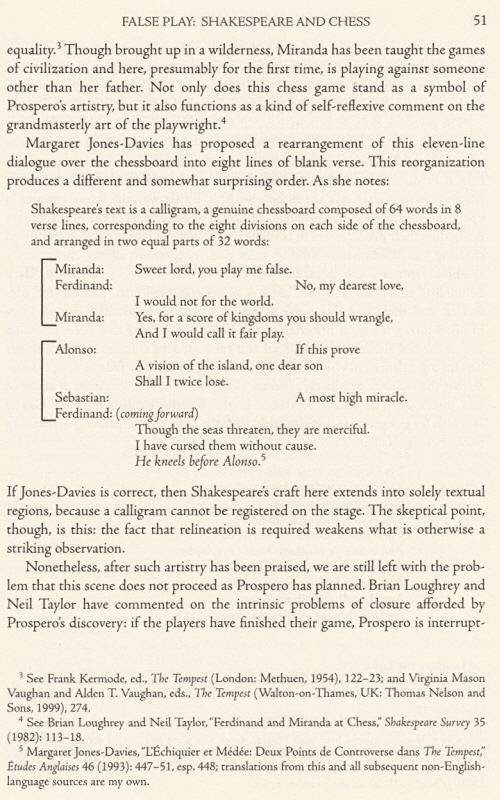
See too our article Chess and Shakespeare.
7444. Postcard
A further contribution from Mr Ross Jackson is this postcard in his collection:
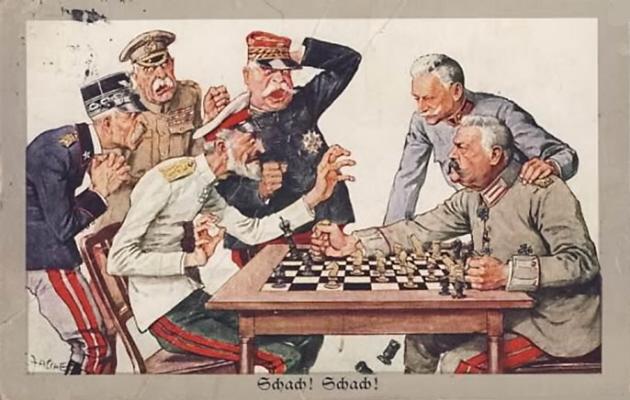
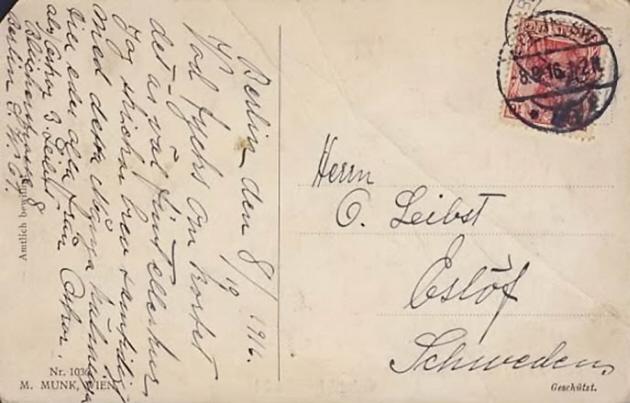
7445. Forgotten brilliancy (C.N. 7433)
Christian Sánchez (Rosario, Argentina) notes that according to page 15 of the Evening Post (Wellington, New Zealand) of 2 January 1932 the Gundersen v Kelling game was played on 1 January, in round eight of the tournament, and that this information is confirmed by the ‘Review of the Tourney’ on page 13 of the newspaper’s 27 January 1932 edition:
‘The Brilliancy Prize. Since the above notes were penned the report of the adjudicators, Messrs. W.E. Mason, W. Mackay, and G.P. Anderson, all of this city, has been received regarding the games entered for the Brilliancy Prize of £2 2s donated by Mr Paul Kummer, a North Island Vice-President of the New Zealand Chess Association. They unanimously place the game mottoed “Queen Sacrifice” first, and consequently Mr Gundersen, the Chairman, gains the Brilliancy Prize for the fine game that he won from F.K. Kelling (Wellington) in round eight on New Year’s Day. The report in the Hawke’s Bay Herald on this game was as follows: “Four Knights’ Opening. Mr Gundersen wove yet another beautiful mating net, the threat that caused the resignation being a double check with rook and bishop after a queen sacrifice.” This game was greatly admired, and the award will cause no surprise. Before leaving Napier Mr Gundersen expressed the opinion that this was the best game that he had played in the tourney. The game placed second was mottoed “Mate in 5”, and is the forceful win that Mr Gundersen scored from Mr Erskine (Southland C.C.) in round six.’
In pointing out that an early appearance of the Gundersen v Kelling game was on page 17 of the Brisbane Courier of 13 February 1932, Mr Sánchez observes that that column also published a battle which John Keeble is said to have described as ‘The Game of the Year’:
G. Hanson – G. Van MindenoOccasion?
Queen’s Gambit Declined
1 d4 d5 2 c4 c6 3 cxd5 cxd5 4 Nc3 Nf6 5 Bf4 Nc6 6 Nf3 e6 7 e3 Qa5 8 Bd3 Bb4 9 Qb3 O-O 10 O-O Nh5 11 Bg5 f6 12 Bh4 Kh8 13 Qc2 g6 14 Bxg6 hxg6 15 Qxg6 Ng7 16 Bxf6 Rxf6 17 Qxf6 Be7 18 Qh6+ Kg8 19 Ng5 Bxg5 20 Qxg5 Bd7 21 e4 Nxd4 22 exd5 Rf8 23 Qg4 Ndf5 24 dxe6 Bxe6 25 Rae1
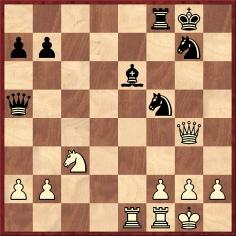
25...Ne3 26 Qg6 Bf5 27 Qg5 Nxf1 28 Re7 Rf7 29 Re8+ Kh7 30 Qh4+ Kg6 31 Rh8 Rd7 32 Rh6+ Kf7 33 Kxf1
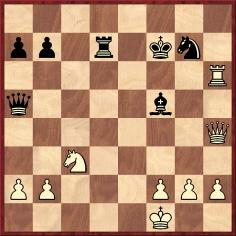
33...Rd1+ 34 Ke2 Rd7 35 Rf6+ Kg8 36 Qc4+ Ne6 37 Qc8+ Rd8 38 Qxb7 Qe5+ 39 Ne4 Bxe4 40 Qf7+ Kh8 41 Qxe6 Bd3+ 42 Kf3 Be2 mate.
What can be discovered about this game?
7446. A debt of gratitude
Very few chess enthusiasts may recognize the name of Guy Bickers, yet he played a major role in the game’s literature. From pages 178-179 of the August 1942 BCM (whose Editor was J. du Mont):

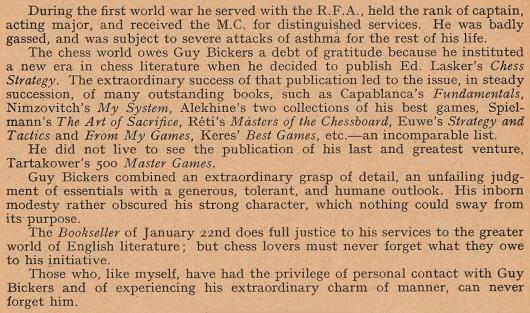
Below from our collection is a brief note, with no apparent chess connection, written by Guy Bickers:
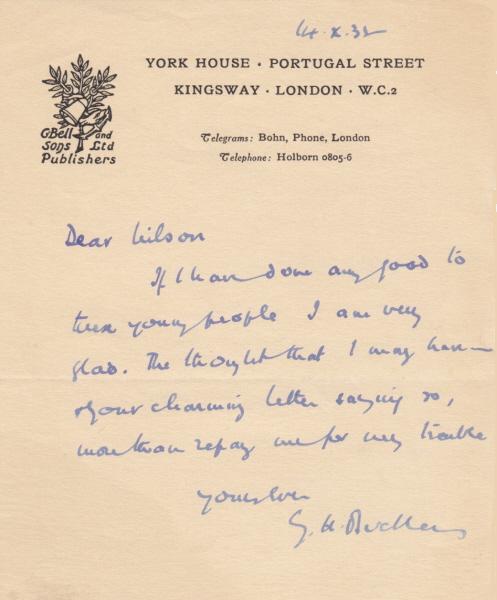
C.N. 6133 reproduced a letter from Bickers to Capablanca.
7447. Knight tours (C.N.s 4937 & 4969)
Awani Kumar (Lucknow, India) draws attention to his recent article Magic Knight’s Tours in Higher Dimensions.
7448. Crown v Korn
Wanted: information about the game below, which was published on page 112 of the April 1943 CHESS, when Crown was aged 13.
Gordon Thomas Crown – Walter KornOccasion?
Sicilian Defence
1 e4 c5 2 Nf3 Nc6 3 d4 cxd4 4 Nxd4 Nf6 5 Nc3 d6 6 Be2 g6 7 O-O Bg7 8 Be3 O-O 9 Nb3 Be6 10 f4 Na5 11 f5 Bc4 12 Nxa5 Bxe2 13 Qxe2 Qxa5 14 g4 Qb4 15 Bd2 Rac8 16 g5 Nd7 17 Nd5 Qd4+ 18 Rf2 Rfe8 19 Bc3 Qc4
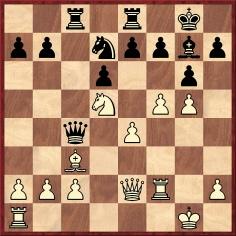
20 Nxe7+ Rxe7 21 Qxc4 Rxc4 22 Bxg7 gxf5 23 exf5 Rg4+ 24 Rg2 Rxg2+ 25 Kxg2 Re2+ 26 Kf3 Rxc2 27 Bc3 Rxh2 28 Rd1 Ne5+ 29 Bxe5 dxe5
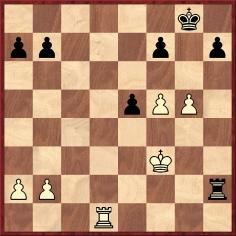
30 f6 h6 31 gxh6 Kh7 32 Rd7 Kg6 33 Rxb7 Kxf6 34 Rxa7 Rxb2 Drawn.
7449. ‘A Game of Chess’
A cartoon feature by C.J. Theriat from page 488 of Harper’s New Monthly Magazine, February 1888:
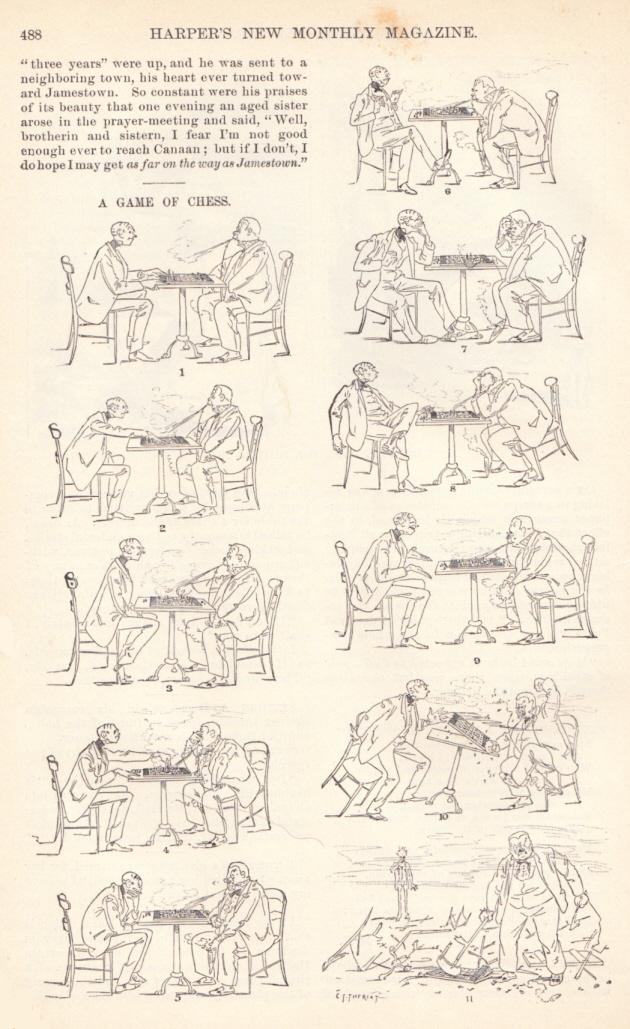
7450. ‘The Small Green Idol’
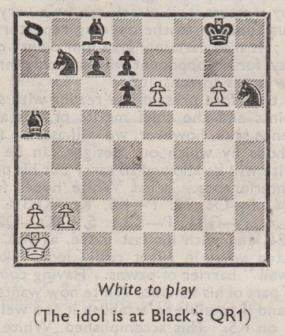
This position occurs in the short story ‘The Small Green Idol’ by Lord Dunsany, where it was stated that White could mate in two moves. Our article Lord Dunsany and Chess gives the full text and other particulars.
7451. Study composers
John Roycroft (London) asks:
‘Is there any photograph of Gleb Zakhodyakin (1912-82) or E.N. Somov-Nasimovich (1910-1942), two noted Soviet-era composers of endgame studies?’
7452. Berne, 1923
The participants in the Swiss national championship of 1923:
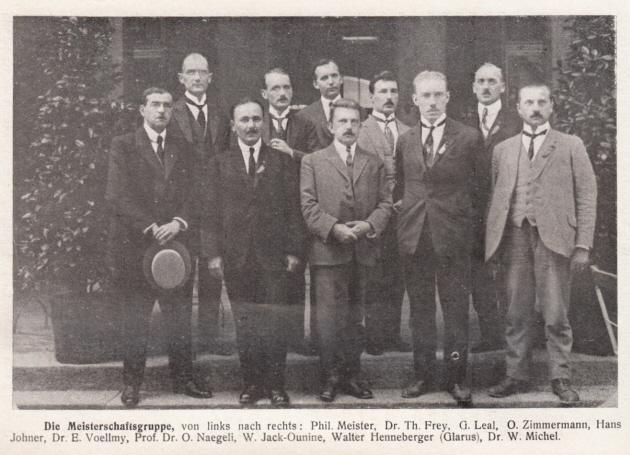
Source: Schweizerische Schachzeitung, August 1923, page 114.
7453. ‘Bunk’
A new feature article offers the spectacle of a prominent intellectual being roasted for writing ‘bunk’.
7454. Paul Whiteman
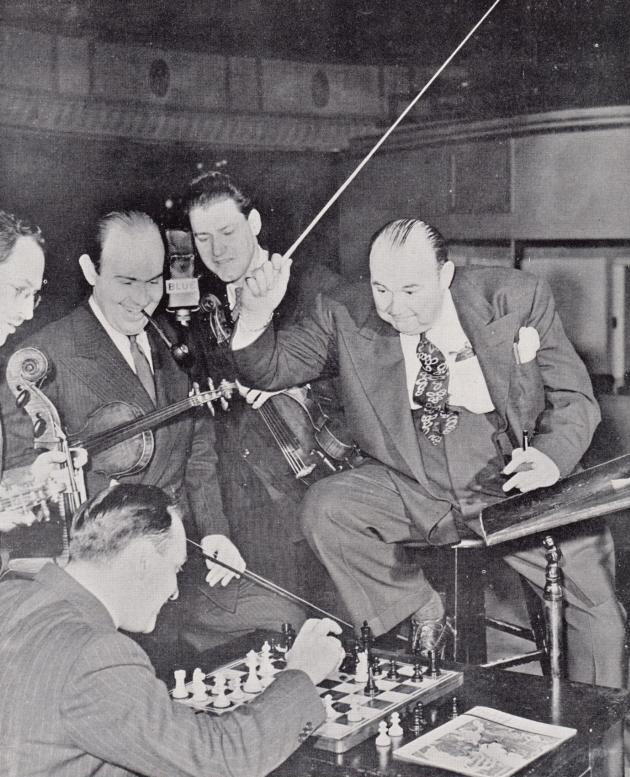
The above photograph was on the front cover of the November 1944 Chess Review, with the following note on page 1:
‘Paul Whiteman, King of Jazz, wields his famous baton in defense of his king, attacked by Chess Review Postalite Leo Kahn, first violinist of the Whiteman orchestra. Looking on are violinist Sylvan Shulman (pipe in mouth) and viola player Ralph Hersh. These and other members of the orchestra are ardent chess fans and play during intermissions. This striking pose was taken at a rehearsal for the Blue Network’s Radio Hall of Fame program.’
7455. Marshall v Janowsky
1 d4 d5 2 Nf3 c5 3 c4 dxc4 4 e3 e6 5 Bxc4 Nf6 6 O-O Nc6 7 Nc3 Be7 8 Qe2 O-O 9 dxc5 Bxc5 10 a3 Bd7 11 b4 Be7 12 Bb2 Rc8 13 Rfd1 Qb6 14 Rac1 Rfd8 15 Na4 Qc7 16 b5 Na5 17 Bxe6 Bxe6 18 Rxc7 Rxd1+ 19 Qxd1 Rxc7
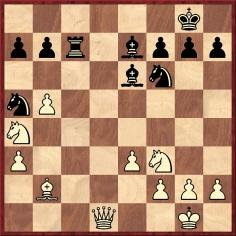
Noting that databases have these moves as a game in the 1912 Marshall v Janowsky match, Pierre Bourget (Quebec, Canada) asks whether the game really ended at move 19 (as a win for White).
The answer is no. The above is less than half of the game, as Janowsky did not resign until move 45. The full score (eighth match-game, Biarritz, 12 September 1912) is on pages 440-441 of La Stratégie, November 1912, the additional moves being: 20 b6 axb6 21 Nxb6 Rc6 22 Na4 Nc4 23 Bxf6 gxf6 24 Nd4 Rc7 25 h4 Bd7 26 Qf3 Ne5 27 Qd1 Bxa3 28 Nc2 Bf8 29 Nb6 Bg4 30 f3 Be6 31 Nd4 h5 32 Nxe6 fxe6 33 Qd8 Rc1+ 34 Kf2 Kf7 35 Nd7 Be7 36 Nxe5+ fxe5 37 Qh8 Bxh4+ 38 Ke2 Bg3 39 Qxh5+ Kf6 40 Qh3 Be1 41 Qh6+ Kf7 42 g4 Bb4 43 g5 Be7 44 g6+ Ke8 45 Qh8+ Resigns.
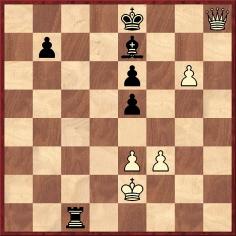
7456. Psychology
In C.N. 559 William Hartston (Cambridge, England) quoted a sentence from a 1960 paper by Félix Martí-Ibáñez:
‘To checkmate the opponent’s king in chess is equivalent to castrating and devouring him, becoming one with him in a ritual of symbolic homosexualism and cannibalistic communion, thus responding to the remnants of the infantile Oedipus complex.’
We now note a slightly earlier appearance of the passage, on page 504 of Martí-Ibáñez’s book Centaur: Essays on the History of Medical Ideas (New York, 1958). It is in an essay ‘On the Psychology of Chess’ (pages 501-508):
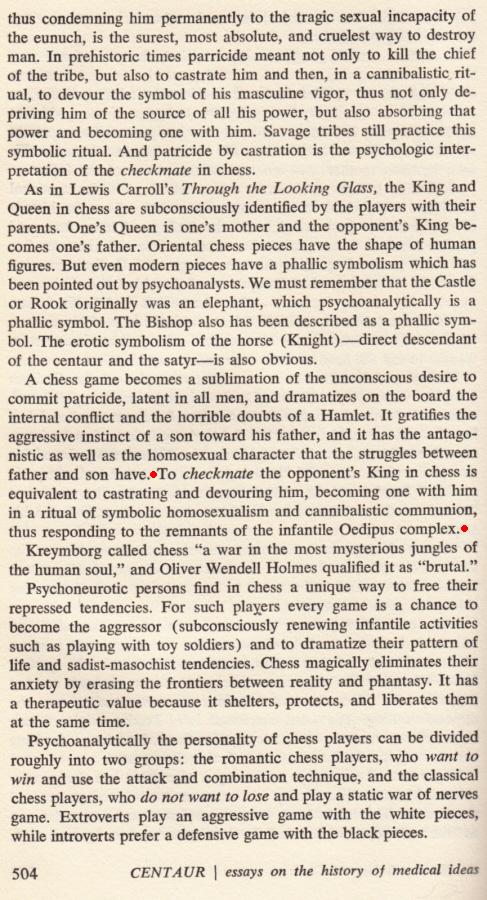
The author’s inscription in our copy:
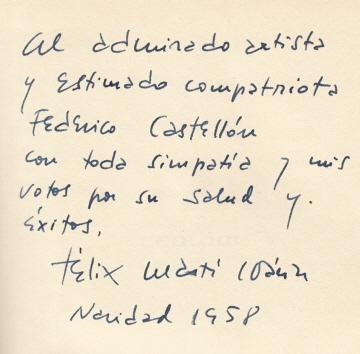
7457. High Life (C.N.s 7430 & 7438)
We have acquired the April 1892 issue of The Strand Magazine, which had the short story ‘The Black Knight’ by Raymund Allen on pages 330-338. The four illustrations featuring chess are given below from, respectively, pages 330, 331, 332 and 337:
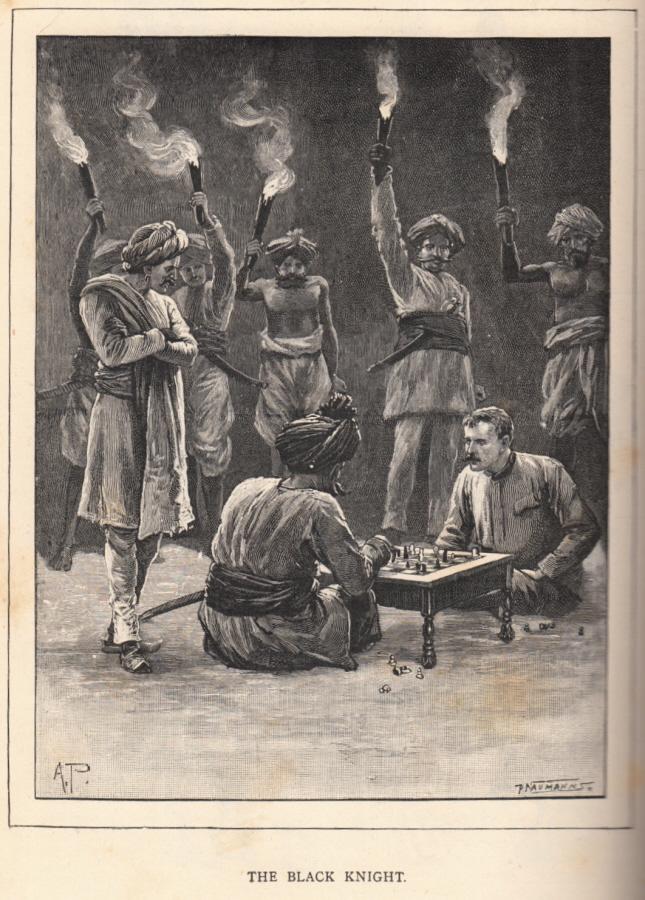
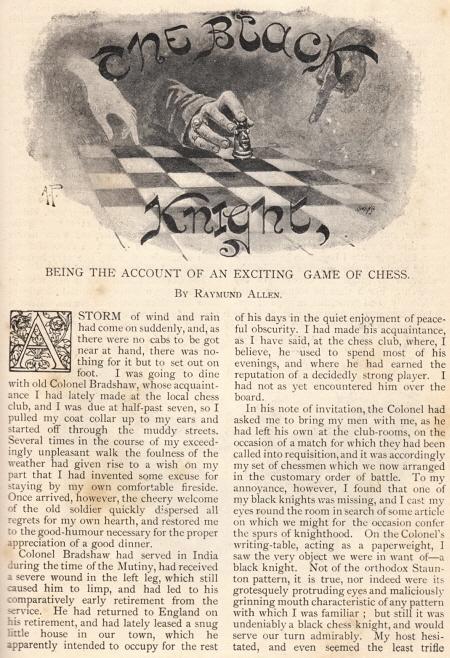
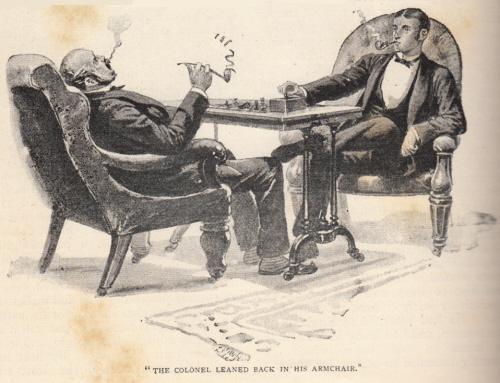
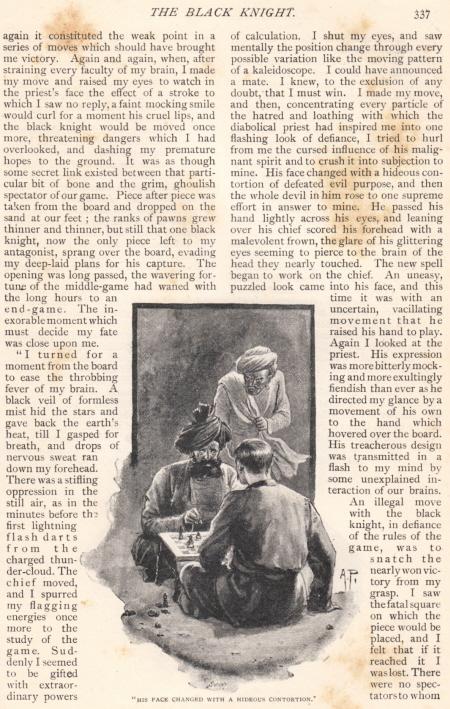
7458. In Russian
Following on from The Saburovs (Сабуровы), a second feature article, The Genius and the Princess, is now available in Russian (Гений и княгиня).
7459. Bonjour Blanc (C.N. 4939)
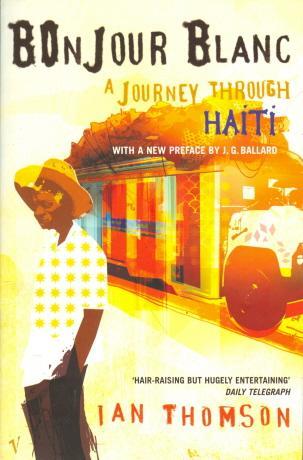
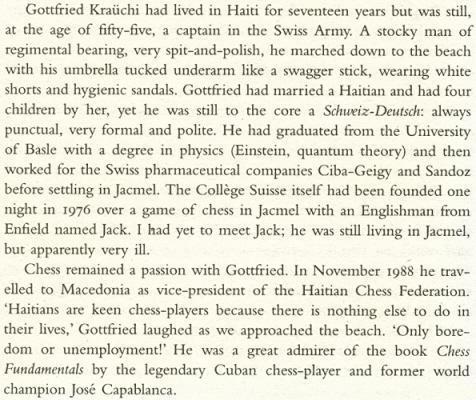
The above material was shown in C.N. 4939, and now Gottfried Kräuchi (Fribourg, Switzerland) has sent us details of his chess activity in Haiti:
‘I introduced chess to the youth of Jacmel, a picturesque town in south-eastern Haiti, where I founded the Collège Suisse and lived for 36 years. After giving some lessons in schools, I founded the Chess Club ALFREC, the “Alliance Française Echecs”. As Vice-President of the Haitian Chess Federation I travelled with the national team in December 1988 to the Olympiad as the non-playing captain. Our team included a 17-year-old from Jacmel, Valéry Afriany, and the author and Haitian champion Gary Victor.
In 1989 the Haitian Chess Federation sent me as FIDE Delegate to the world governing body’s Congress in Mayagüez, Puerto Rico.
The Haitian Chess Federation has organized two memorial tournaments named the “Coupe Gottfried Kräuchi”. However, although nearly 78 years old, I am still among the living.’
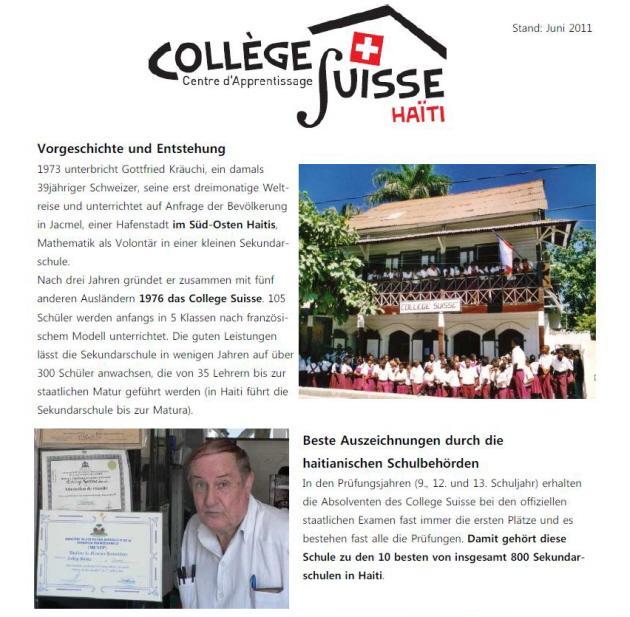
For further information see Collège Suisse Haïti and Haiti: Schweizer Schule Jacmel vor Neubeginn.
7460. Medley and time
From the obituary of George Webb Medley on pages 13-14 of the January 1899 BCM:
‘To Mr Medley’s efforts must be attributed the acceptance of a time-limit in chess matches. Before this condition operated, chess matches were sometimes of portentous duration, as witness the championship match, Staunton versus St Amant. Indeed, it was no uncommon thing for notes like these to be attached to games. “No move has been made for an hour and a quarter.” “Both players appear to be asleep.” Mr Medley himself has stated that Harrwitz once took half an hour over his first move. From this abyss of gross stupidity the time-limit has saved us, and for this Mr Medley deserves well of the chess world.’
This photograph of Medley comes from opposite page 82 of A Century of British Chess by Philip W. Sergeant (London, 1934):
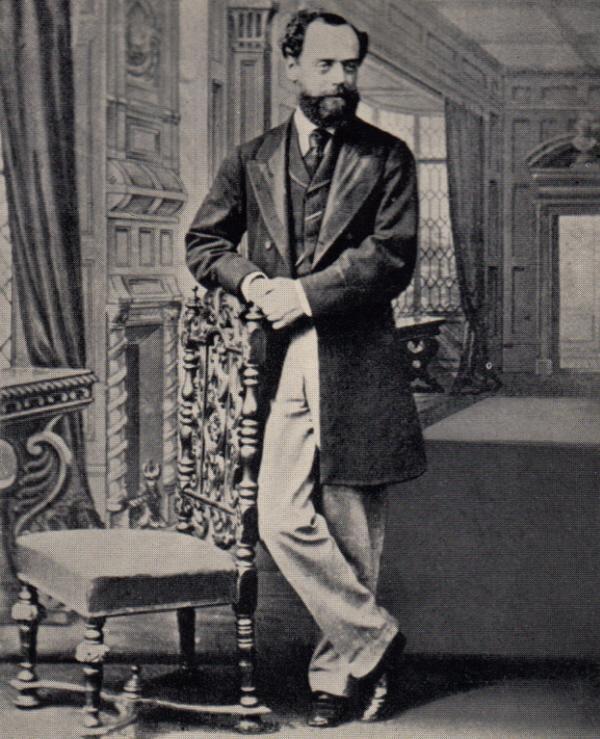
7461. In the Good Old Days
Eduardo Bauzá Mercére (New York, NY, USA) submits a
game from page 16 of the Brooklyn Daily Eagle,
26 May 1927:

Brooklyn, 15 April 1883
King’s Gambit Accepted
1 e4 e5 2 f4 exf4 3 Nf3 g5 4 Bc4 g4 5 Ne5 Qh4+ 6 Kf1 f3 7 d4 d5 8 Bxd5 fxg2+ 9 Kxg2 Qh3+ 10 Kg1 Nh6 11 Bf4 Bg7 12 c3 c6 13 Bc4 Nd7 14 Nd3 Nb6 15 Nf2
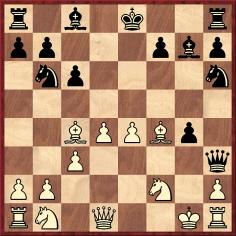
15...Nxc4 16 Nxh3 gxh3 17 Qd3 Nxb2 18 Qe2 Na4 19 Qd2 Ng4 20 Na3 Nb6 21 Rd1 Nf6 22 Qd3 Nh5 23 Be3 Bg4 24 Rf1 O-O 25 Nc4 Nxc4 26 Qxc4 Rae8 27 e5 Re6 28 Kf2 b5 29 Qc5 f5 30 Ke1 Rf7 31 Qb4 Bf8 32 Qb3 Ng7 33 Rhg1 Rg6 34 d5 cxd5 35 Qxd5 Ne6 36 Qxb5 h5 37 Qd3 Kg7 38 a4 f4 39 Bd4 Kh6 40 Qd2 Rg5 41 Qf2 Rd7 42 Qb2 Nxd4 43 cxd4
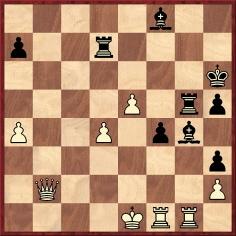
43...Rxe5+ 44 Kf2 Rxd4 45 Rxg4 hxg4 46 Rc1 Red5 47 Rc2 Bc5 48 Rxc5 Rd2+ 49 Qxd2 Rxd2+ 50 Kg1 Rd1+ 51 Kf2 g3+ 52 hxg3 h2 53 Rc6+ Kh5 54 Rc5+ Kg4 55 White resigns.
7462. Leo Tolstoy
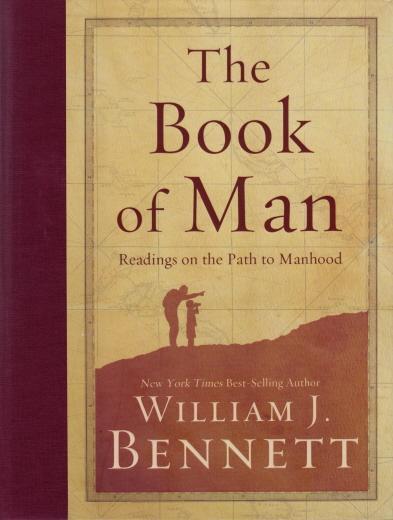
From page 208 of The Book of Man by William J. Bennett (Nashville, 2011):
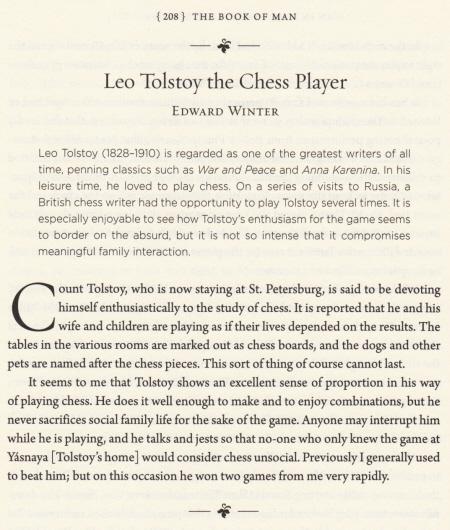
The source of these personal insights is specified in the bibliography on page 525:
As will be seen in our article Tolstoy and Chess, the paragraph beginning ‘Count Tolstoy ...’ is a brief unsigned news item on page 168 of the May 1897 BCM, while the paragraph which starts ‘It seems to me ...’ was quoted by us from pages 627-628 of The Life of Tolstoy Later Years by Aylmer Maude (London, 1910).
The back cover of The Book of Man states that Dr William J. Bennett ‘served as Secretary of Education under President Ronald Reagan’.
7463. New York, 1936
From page 9 of Chess Review, December 1944:
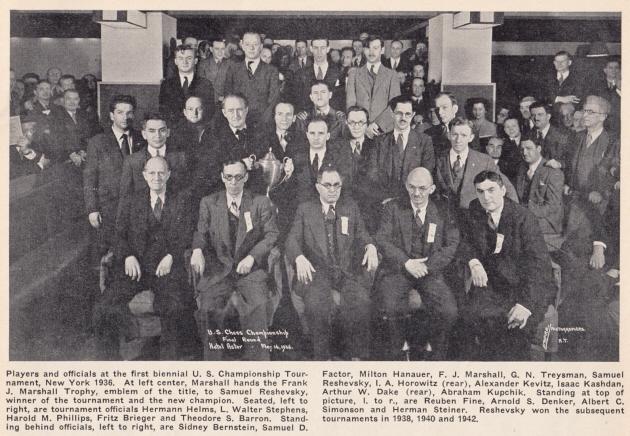
7464. Short stories by Raymund Allen (C.N.s 7438 & 7457)
Michael Clapham (Ipswich, England) notes that page 523 of Douglas A. Betts’ Annotated Bibliography mentioned another chess story by Raymund Allen:

We add that ‘A Happy Solution’ was subsequently anthologized on pages 234-250 of Chess in Literature by Marcello Truzzi (New York, 1974). Moreover, in the December issues of The Strand of 1913, 1914 and 1915 there were also chess stories by Allen, as reported by T.R. Dawson in his ‘Endings’ column in the Chess Amateur.
January 1914, page 109:
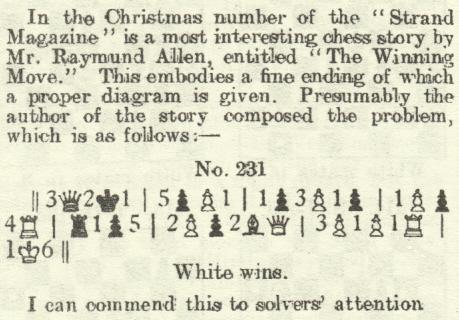
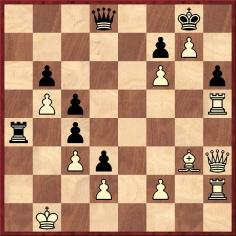
January 1915, page 113:
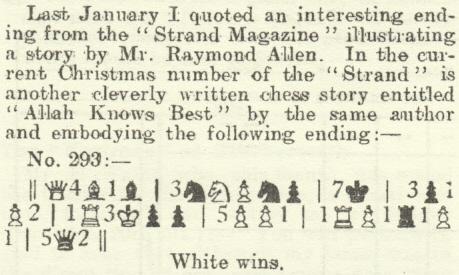
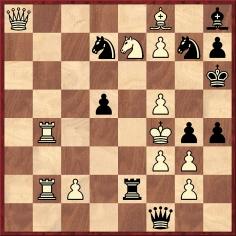
January 1916, page 111:
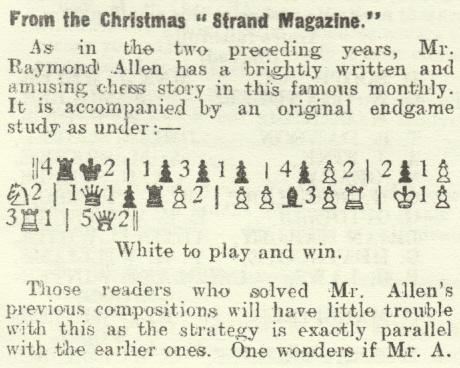

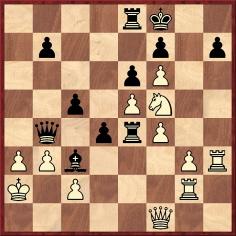
7465. Neville Chamberlain
From page 105 of CHESS, 14 November 1938:
‘... Neville Chamberlain has accepted the Presidency of the Warwickshire Chess Association, though he has never played a game of chess in his life.’
A further distinction came 50 years later when he appeared on the front cover of the Special Munich Agreement Anniversary Issue (‘piece play for our time’) of a chess magazine.
7466. Frank Sinatra and chess
Page 185 of the July-August 1963 Chess Life had this news item in its coverage of the Piatigorsky Cup tournament in Los Angeles:
‘Most commotion of the tournament to date was caused when Frank Sinatra and Mike Romanoff walked in. Tigran Petrosian temporarily lost his title as most-stared-at individual.
The City of Hope was holding a convention at the hotel, and some of the ladies spotted Sinatra. Result – a rush to the playing room that was halted by some fast blocking on the part of our officials.’
A photograph of Sinatra with Walter Browne (and with the time-honoured ‘board problem’) was published on page 24 of Chess Life, May 1982:
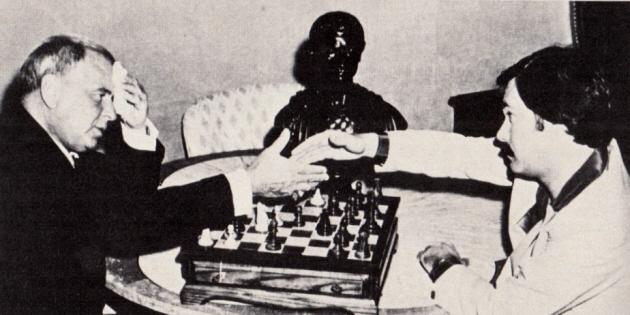
7467. Elaine Saunders/Pritchard (1926-2012)
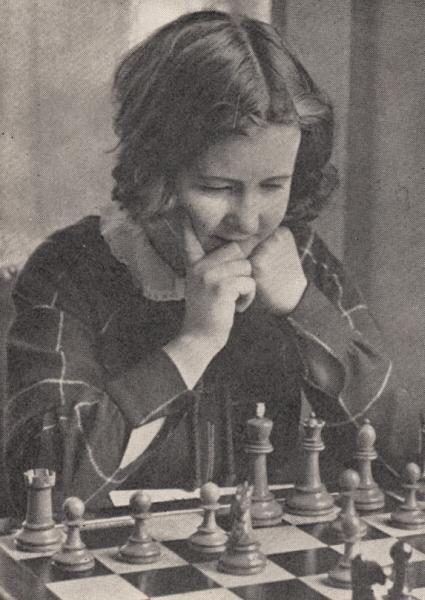
This photograph of Elaine Saunders comes from page 18 of Alt om Skak by B. Nielsen (Odense, 1943).
On 28 March 1991 the late David Pritchard wrote to us:
‘I thought Elaine (my wife) had played Capa in a simultaneous but apparently not. She recalls however travelling to Lewisham in a carriage with him and Vera Menchik (top man, top woman, top girl) for some special occasion. The top boy (Frank Parr) travelled separately. Her only recollection is that she didn’t like him (Capa) very much – perhaps she was intimidated.’
Is anything known about the ‘special occasion’?
7468. Réti studies
It has not yet been possible to discover the full story about either of the Réti studies given in C.N.s 7283 and 7316.
This one has been found nowhere else so far:
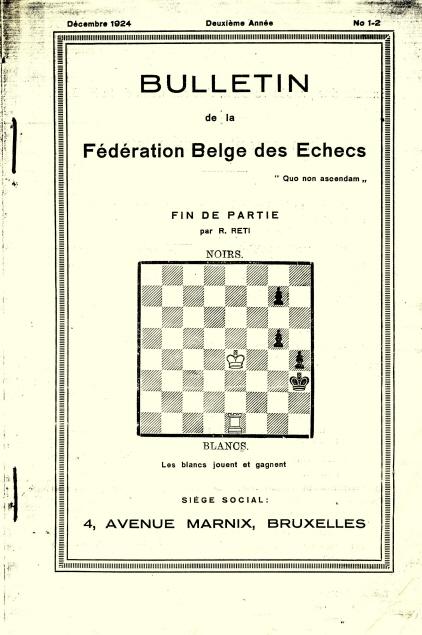
As regards the second one, shown below as it appeared on page 26 of Richard Réti: Sämtliche Studien (Mährisch-Ostrau, 1931), nothing has been traced in the Tijdschrift van den Nederlandschen Schaakbond.
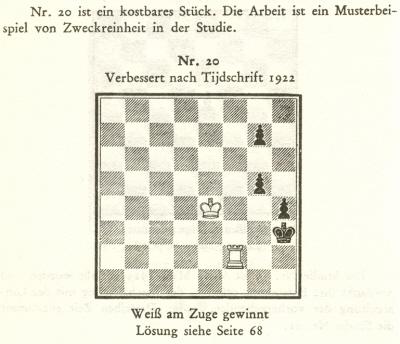
More generally, we draw attention to John Beasley’s compilation of studies by Réti.
7469. Crown v Korn (C.N. 7448)
Nothing has yet come to light regarding the game played by Gordon Crown at the age of 13, as published on page 112 of the April 1943 CHESS. We note, though, that Crown had already been in contact with the magazine by that time. From page 68 of the February 1943 issue:

7470. Oxbridge photographs
From Olimpiu G. Urcan (Singapore):
‘Historical photographs involving Oxbridge chessplayers in inter-varsity matches seem scarce. I am particularly interested in group illustrations featuring members of the Cambridge University chess team in the late 1890s and the early twentieth century. Among others, the active members were C.E.C. Tattersall, H.A. Webb, E.E. Colman, H.G. Softlaw, J.E. Wright, C.C. Wiles, B. Goulding Brown, W.S. Ostle, F.K. Loewenthal, F.W. Clarke, and E.W. Burnell.
One such illustration appeared on page 129 of the July 1901 edition of Womanhood, in Rhoda A. Bowles’ chess column:
Are C.N. readers able to find further such photographs?’
7471. Breyer
We also appeal for good-quality photographs of Gyula Breyer. Tartakower’s Die Hypermoderne Schachpartie (Vienna, 1924) – see page 320 – did no better than this:
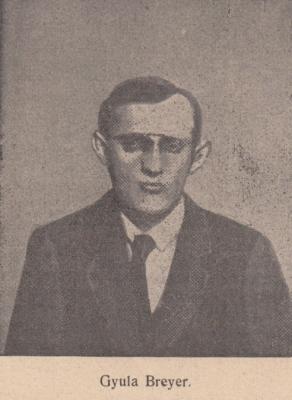
7472. Steinitz stuck
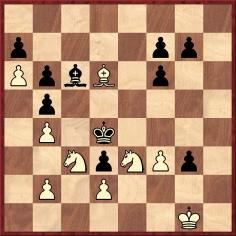
Mate in four
Further to the discussion regarding this problem by Sam Loyd (Mirror of American Sports, 10 October 1885) in Steinitz Stuck and Capa Caught, Steven B. Dowd (Birmingham, AL; USA) writes:
‘The Mirror of American Sports chess column is available online from the Cleveland Digital Library. Loyd’s composition was published as “Tourney Problem No. 6” under “S.S.”:
The tourney was described as follows:
“The Mirror of American Sports’ Third Problem and Solution Tourney, for the solving championship of the world, will begin with the issue of 3 October 1885 and continue five months, ending 27 February 1886.”
I believe that this announcement came in the issue of 3 October; although the column in question is not dated, it precedes the 10 October one, and elsewhere in that column it is noted that “The Fun Begins Today” in reference to the tourney. It is sometimes difficult in the pdf file to determine where columns end and begin.
The solution was given in the 28 November 1885 issue, where the dual 2 Bb8 was noted.
Another interesting note was published under “Chess Chips” in what appears to be the 26 December 1885 issue:
“Mr Loyd writes, ‘I saw Zukertort today, and he solved the “S.S.”! Do you think it prognosticates anything?’ It may have ‘prognosticated’ that Zukertort had seen the problem and ‘tumbled’ to it before he left the old country.”
This, of course, is in reference to the upcoming match between Zukertort and Steinitz.
There is nothing indicating that Loyd revised the problem to reflect S. Pickard’s rendition.
The winner of the tourney was Johann Berger, followed by G.C. Reichhelm and with B.G. Laws in third place.’
7473. Under Waterloo Bridge
This article by G.H. Diggle comes from page 85 of Chess Characters (Geneva, 1984), having originally appeared in the August 1982 Newsflash:
‘In what is hoped will now become an annual tradition, a large number of rapid and well-organized murders, masterminded by that genial “Moriarty” Richard Beville, and generously sponsored once again by CHESS, were perpetrated under Waterloo Bridge on Saturday, 19 June, when the “second South Bank Open Air Speed Chess Tournament”, while not including quite such a galaxy of evil genius as last year, nevertheless attracted to the scene a good muster of well-known criminals such as Michael Basman, John Nunn, B. Cafferty, J. Levitt, M. Pein and “Bob” Wade, with a “supporting cast” of some 30 “selected victims”. The weather was once again worthy of the Falklands on an indifferent day, but spectators who were not prepared to shiver outside could always drink coffee in the Theatre Restaurant, or browse over a large bookstall provided by CHESS and containing works with such alluring titles as Chess Scandals, Persona non Grata and Massacre in Merano, together with many “Do it Yourself” Guides covering every aspect of the game – How to Play The Nimzo-Indian Defence, How to get more from your Chess Computer – though surprisingly, no new work seems to be in print (“specially recommended for all chess bookstall patrons”) on How to peruse without purchasing with an Appendix of 50 pages containing “Tactical Hints for Booklifters”.
The BM, whenever he makes one of his increasingly rare incursions into chess society, is beginning to feel more and more like the Ghost in Hamlet “revisiting the glimpses of the moon”. This feeling was accentuated on this occasion when, instead of being placed in the lists against Grandmaster Nunn or others of that liver and kidney, he found himself playing (“All Hell shall stir for this!”) in a quasi-juvenile section which included three schoolboys aged about eight to ten. This trinity, against whom he pulled off two wins and one loss, received him into their midst with tolerant friendliness if with disappointingly little awe – admittedly the BM’s deportment lacked its usual majesty as he was muffled up against the elements in a large greatcoat and his ancient trilby was squashed down over his ears to prevent its being blown into the Thames. All three opponents, to their great credit, opened with P-K4 (chess has long been “dying of a surfeit of Sicilian lampreys”) – moreover, their chessboard demeanour was perfect, and all handshakes were performed in true pump-handle style. The two losers were both gracious in defeat, and though one remarked that “it was probably the worst game he had ever played in his life” it was said with a sorrowfully judicial air as though over half a century of active chess had risen up in his memory.’
7474. Leftwards and rightwards
Further to the reference in C.N. 7466 to the ‘board problem’, a far rarer occurrence is an inverted diagram in a book. An example comes from page 174 of Il mio amico Karpov by D. Bjelica (Abano Terme, 1981):
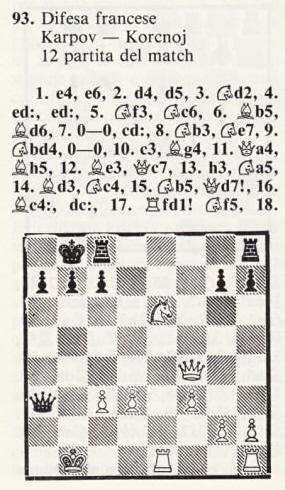
The position (after 21 Nxd6) was correct in the original edition; see page 252 of Rekao mi je Anatolij Karpov (Belgrade, 1981).
As shown above, the Italian book also had ‘inverted figurines’ (i.e. knights and bishops). These were also used, in game-scores and diagrams, in Chequers Chess Publication volumes of the 1980s. The example below is in a game between Kasparov and Nunn, from page 171 of The Brussels Encounter by W. Hartston, W. Iclicki and R. Lancaster (London, 1987):
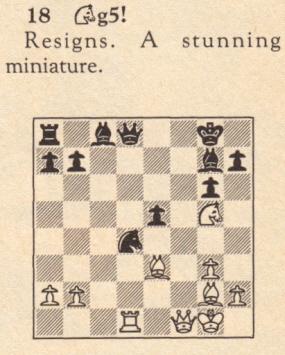
On page 426 of the 30 July 1955 CHESS an unnamed customer complained about a celluloid chess-set in which the knights faced to the right. In the 30 September 1955 issue (page 454) a reader, W.H. Duce, commented: ‘In the cardboard chessmen of the Portland sets the king’s knight faces left but the queen’s knight faces right ...’ See also page 27 of the January 1987 BCM and page 120 of the March 1987 issue.
7475. Chess astray
An item not readily found nowadays was being sold by CHESS in the mid-1950s. From the front cover of the 2 April 1955 issue:
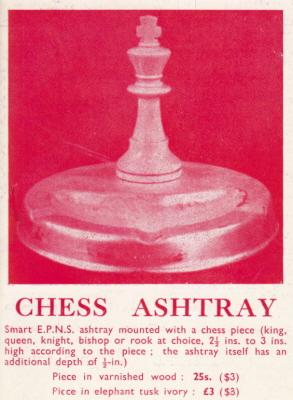
7476. Simultaneous display
Alain Biénabe (Bordeaux, France) wonders what is known about this photograph in his collection:
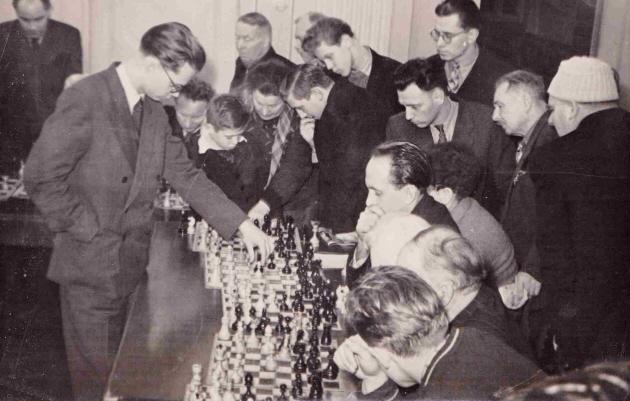
The reverse side has this:
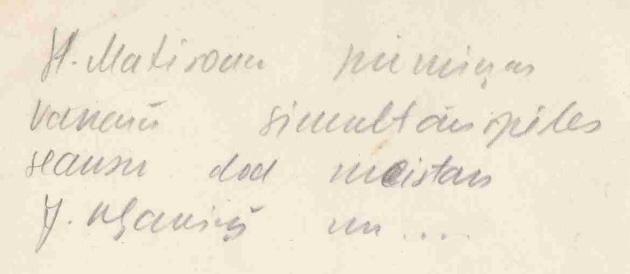
7477. Poltergeists
C.N. 3162 (see page 118 of Chess Facts and Fables) quoted this footnote on page 262 of Historic British Ghosts by P.W. Sergeant (London, 1936):
‘I have only come across one alleged instance, very trivial. A well-known chessmaster among my friends appeared to be troubled at one time with such a visitant. The books on chess in his library would be found lying on the floor, would fall out of the shelves at night; always and only chess books, though there were more books on other subjects. And a photograph of some chess celebrity fell from the wall, with its glass broken. There was no explanation. A selective cat could hardly be blamed. The manifestation did not last for more than a very few weeks.’
We add the following from pages 35-36 of CHESS, December 1942 (where Kersch should read Kersh):
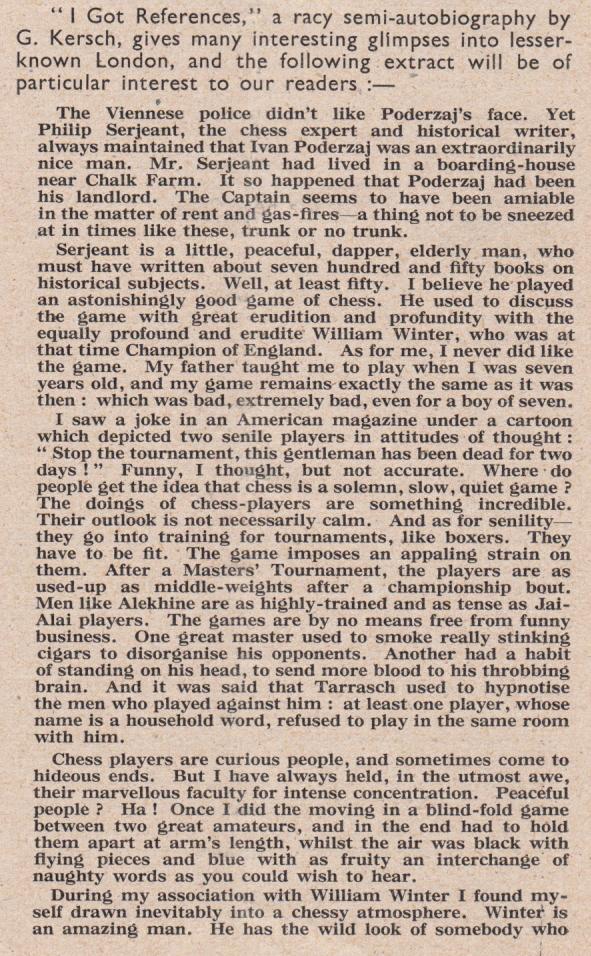
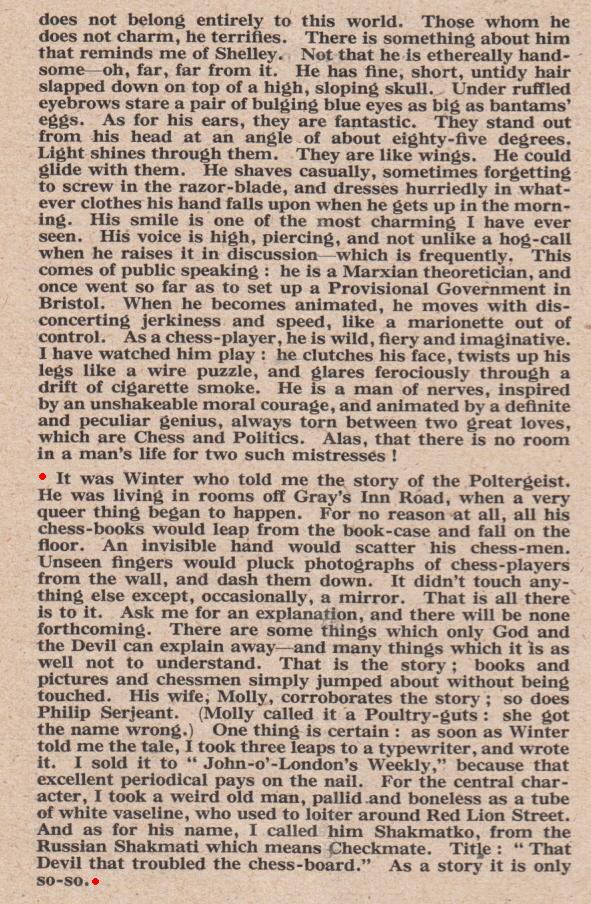
If a reader has I Got References by Gerald Kersh, we shall be grateful to know whether it contains any other chess-related material.
7478. Śliwa at the 1964 Olympiad
Konrad Ciborowski (Cracow, Poland) refers to the failure of Bogdan Śliwa (1922-2003) to obtain the grandmaster title in the mid-1960s.
‘At the 1964 Chess Olympiad in Tel Aviv the Polish team was Zbigniew Doda, Jacek Bednarski, Bogdan Śliwa, Andrzej Filipowicz, Witold Balcerowski and Włodzimierz Schmidt. Playing on board three, Śliwa scored 9/14, beating two grandmasters (Bisguier and Tringov) and drawing with Botvinnik.
From page 263 of Olimpiady szachowe 1924-1970 (Warsaw, 1972) by Stanisław Gawlikowski:
“The team was well prepared; both the team manager K. Kryński and the playing captain A. Filipowicz made very few mistakes with the line-up for individual matches and were firm believers in the notion that in team events the only thing that matters is the team score, and that all individual plans and goals are secondary.”
On page 40 of Polscy szachiści (Warsaw, 1976), Władysław Litmanowicz commented:
“During the 16th Olympiad Śliwa nearly became a grandmaster. Well, that statement is not really accurate, since in fact Śliwa did achieve the grandmaster norm. However, the title was not awarded to him as the rules then in place required a competitor to play at least 15 games. Somehow it did not occur to either the team manager or the captain to take a closer look at Śliwa’s individual score. It is almost laughable that Śliwa was kept on the sidelines during the last match, against Romania. If only Caissa had bothered to inspire the Powers That Be of our team, Poland would have had a grandmaster as early as 1964.”
On the other hand, when Litmanowicz covered the Olympiad for Szachy at the time (see pages 33-43 of the 2/1965 issue) he mentioned no such matter concerning Śliwa.
Is it true that with his nine points Śliwa would have become a grandmaster if only he had played, and regardless of the result, in the last round of the 1964 Olympiad?’
7479. Francisco Lupi (C.N.s 4388 & 5551)
Basic biographical information about Francisco Lupi is
still being sought. As noted by Javier Asturiano Molina
(Murcia, Spain) in Escacultura,
page 29 of Ajedrez Español, January-February 1954
merely stated that Lupi had died in Madrid recently. No
date of birth has yet been found.
7480. Paris, 1924
Our article on the history of FIDE includes a group photograph taken in Paris in 1924. Eduardo Bauzá Mercére (New York, NY, USA) now draws attention to a similar picture which was an insert between pages 300 and 301 of El Ajedrez Argentino, September 1924:
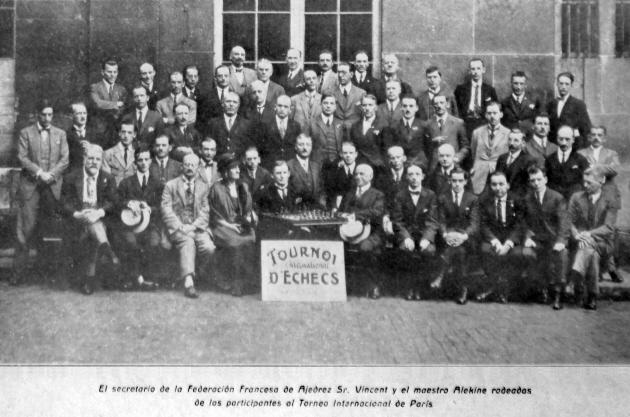
7481. Cable match
From Olimpiu G. Urcan (Singapore) comes a sketch on page 32 of the Westminster Budget of 15 March 1895:
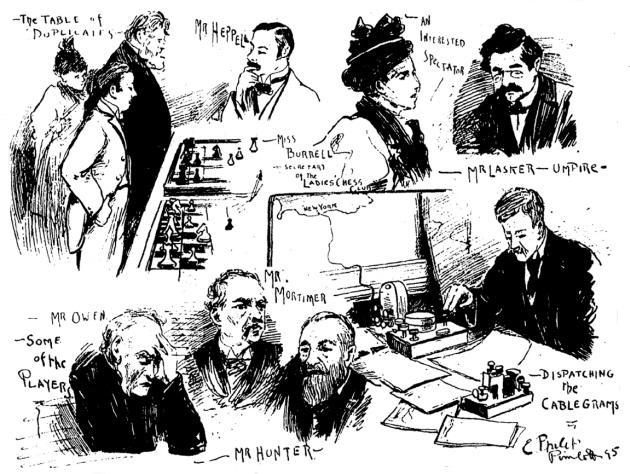
The event was the cable match between the British Chess Club (London) and the Manhattan Chess Club on 9 March 1895 (BCM, April 1895, pages 172-176).
7482. Nellie
Showalter
The following report, from page 8 of the New York Herald, 12 January 1896, has also been submitted by Mr Urcan:

Is anything further known about Nellie Showalter v Louis Schmidt?
7483. Frederick M. Edge
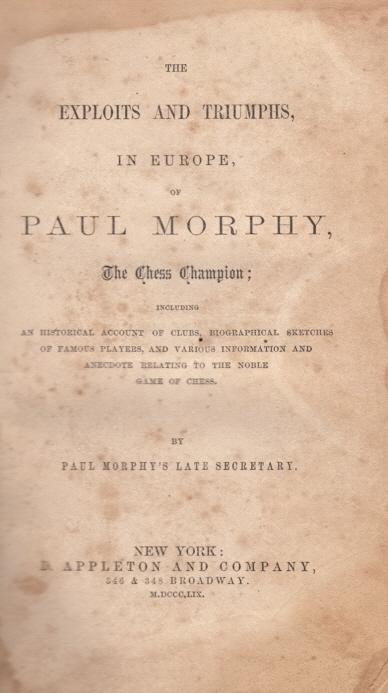
Over the past three decades much has been discovered about Frederick M. Edge (1830-82), and we are now grateful to John Townsend (Wokingham, England) for further information, including the fact that Edge served a prison sentence. Three announcements in the London Gazette have been found by our correspondent:
‘Frederick Milnes Edge, late of No. 49, Hanover-street, South Belgravia, in the county of Middlesex, Author, and now a Prisoner for Debt in the Debtors’ Prison for London and Middlesex, having been adjudged bankrupt by a Registrar of the Court of Bankruptcy, in London, attending at the Prison aforesaid, on 18 August, 1865, and the adjudication being directed to be prosecuted at the Court of Bankruptcy in London, is hereby required to surrender himself to William Hazlitt, Esq., a Registrar of the said Court, at the first meeting of creditors to be held before the said Registrar, on the 15th day of September next, at eleven o’clock in the forenoon precisely, at the said Court. Mr George John Graham, of No. 25, Coleman-street, London, is the Official Assignee.’
Source: London Gazette, 29 August 1865, page 29.
Mr Townsend comments:
‘Imprisonment for debt did not cease until 1869. Edge’s position was that of an insolvent debtor, but it was in his interests to qualify as a bankrupt, since otherwise he could have spent much longer in prison. To declare oneself bankrupt, one had to be a trader, owe more than £50, and petition the court. Edge’s claim to being a trader seemed to rest on his occupation as an author.’
The London Gazette of 3 October 1865, page 32 reported that Edge would be petitioning for his discharge the following month:
‘… a public sitting for the said bankrupt to pass his Last Examination, and make application for his Discharge, will be held before Edward Goulburn, Serjeant-at-Law, a Commissioner of the said Court, on 10 November next, at the said Court, at Basinghall-street, in the city of London, at 12 o’clock at noon precisely, the day last aforesaid being the day limited for the said bankrupt to surrender. Mr George John Graham, of No. 25, Coleman-street, London, is the Official Assignee, and Mr W.W. Aldridge, of No. 46, Moorgate-street, London, is the Solicitor acting in the bankruptcy.’
Our correspondent notes, however, that Edge was still behind bars in March of the following year. Page 56 of the London Gazette, 2 March 1866 stated that a date for another hearing had been set:
‘... a public sitting for the said bankrupt to pass his Last Examination, and make application for his Discharge, will be held before Edward Goulburn, Serjeant-at-Law, a Commissioner of the said Court, on 19 March instant, at the said Court, at Basinghall-street, in the city of London, at one o’clock in the afternoon precisely, the day last aforesaid being the day limited for the said bankrupt to surrender …’
Mr Townsend comments:
‘Edge was presumably released soon after this. Shortly afterwards he had a brief career as Secretary of the Northern Branch of the Reform League, but resigned on 11 January 1867 and sued his employer for libel on the grounds that a newspaper article imputed to him by innuendo that he had obtained money by false pretences, and attempted to collect money ostensibly for the League but really to be applied to his own purposes. Edge cleared his name. (See pages 119-120 of my book Notes on the life of Howard Staunton.)’
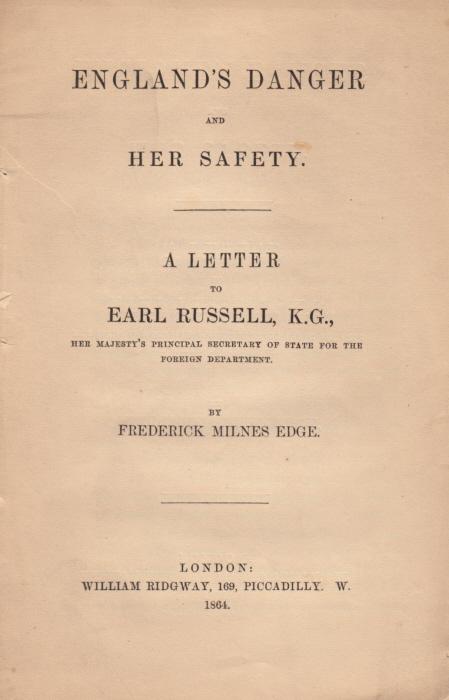
7484. Study composers (C.N. 7451)
No photograph of E.N. Somov-Nasimovich has yet been found, but John Roycroft (London) reports that two portraits of Gleb Zakhodyakin have been pointed out, by Daniel Keith (Molsheim, France) and Harrie Grondijs (Rijswijk, the Netherlands) respectively:
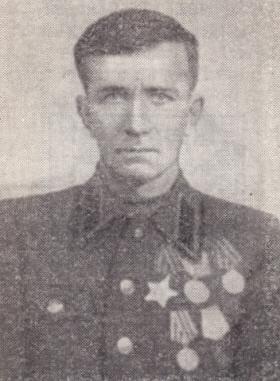
Galereia Shakhmatnykh Etiudistov by F.S. Bondarenko (Moscow, 1968), page 90
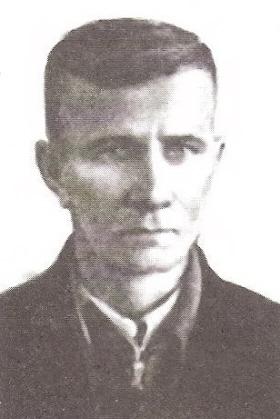
Volume four of El arte del estudio de ajedrez by Zoilo R. Caputto (Buenos Aires, 2000), page 235
7485. Nellie Showalter (C.N. 7482)
Russell Miller (Vancouver, WA, USA) notes a webpage which provides family details about Nellie Love Marshall Showalter (with a different year of birth from the one shown in C.N. 7482).
The game referred to in our earlier item has been found by Jerry Spinrad (Nashville, TN, USA), with notes by the loser, in Jackson Whipps Showalter’s column in the New York Recorder of 2 December 1894:
Nellie Love Marshall Showalter – Louis Schmidt
Venue?, 29 November 1894
Scotch Game
1 e4 e5 2 Nf3 Nc6 3 d4 exd4 4 Nxd4 Nf6 5 Nxc6 bxc6 6 Bd3 d5 7 e5 Ng4 8 Bf4 Bc5 9 O-O O-O 10 h3 g5 11 Bg3 Nh6 12 Qh5 Kg7 13 Nd2 Nf5 14 Nf3 h6 15 Bh2 Rb8 16 g4 Nd4 17 Nxd4 Bxd4 18 c3 Bb6 19 e6 Qf6 20 Rae1
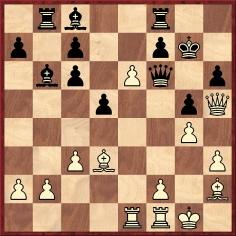
20...Qg6 21 Be5+ Kh7 22 e7 Re8 23 Bf6 Ba6
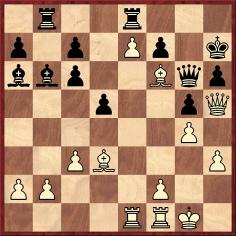
24 Bb1 d4 25 cxd4 Bxf1 26 Bxg5 Qxb1 27 Qxf7+ Kh8 28 Bf6 mate.
7486. Otto von Bismarck’s mother (C.N. 4908)
Still being sought: corroboration of a chess-related claim on page 106 of Living Leaders of the World (Chicago and St Louis, 1889):
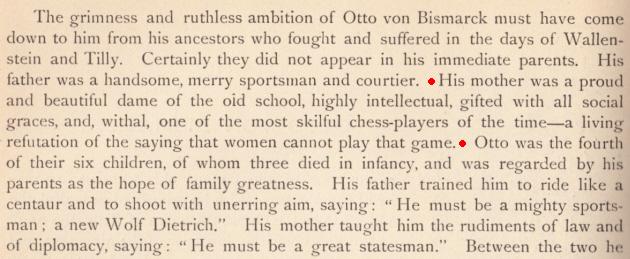
7487. Lightning win
‘A typical, sparkling, ten-second contest replete with hair-raising escapes, astonishing sacrifices, counter-sacrifices, furious assaults on both kings and amusing, child-like blunders.’
That was Santasiere’s description of a game which he won in a rapid-transit tournament at the Marshall Chess Club:
Anthony Edward Santasiere – ShedlovskyNew York, 1926
Center Counter-Game
1 e4 d5 2 exd5 Qxd5 3 Nc3 Qa5 4 b4 Qxb4 5 Rb1 Qd6 6 Nf3 a6 7 Bc4 e6 8 d4 Nf6 9 O-O b5 10 Bd3 Bb7 11 Qe2 c5 12 dxc5 Qxc5 13 Nxb5 axb5 14 Rxb5 Qc7 15 Nd4 Bd6
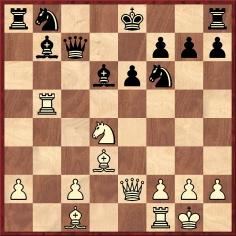
16 Nxe6 fxe6 17 Qxe6+ Kf8 18 Bh6 Bxh2+ 19 Kh1 Bxg2+ 20 Kxg2 Be5 21 Rxe5 Ra6 22 Qf5 Kf7 23 Bxa6 gxh6 24 Bd3 Rg8+ 25 Kh3 Nbd7 26 Re3 Rg5 27 Qf3 Rh5+
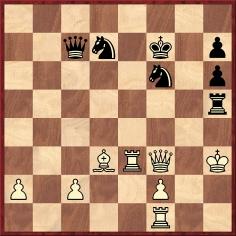
28 Qxh5+ Nxh5 29 Rf3+ Ndf6 30 Bxh7 Nf4+ 31 Kh4 Qe5 32 Rb1 Qh5+ 33 Kg3 Ne4+ 34 Kxf4 Resigns.
The score has been supplied by Eduardo Bauzá Mercére (New York, NY, USA), from page 4A of the Brooklyn Daily Eagle, 23 September 1926:
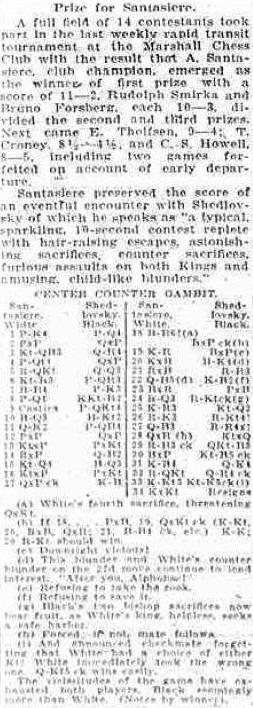
A basic computer-check suggests many improvements to Santasiere’s annotations.
7488. Marshall v Showalter match
Pierre Bourget (Quebec, Canada) notes this photograph on page 230 of the December 1941 Chess Review:
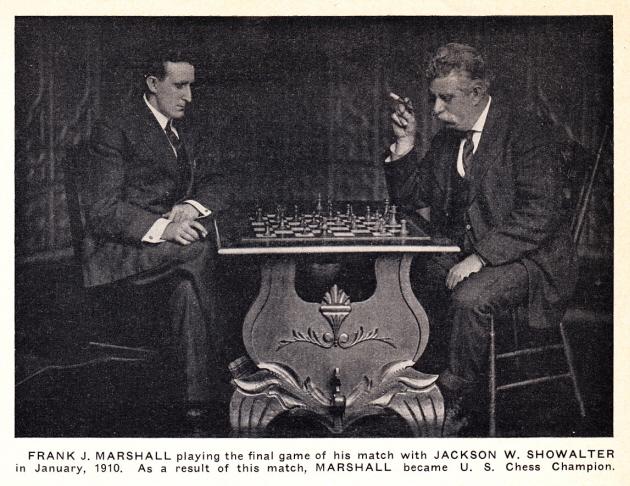
In fact, the match ended on 26 November 1909 (American
Chess Bulletin, January 1910, page 7), and the
board position bears no relation to the final match-game
(in which Marshall was White). The photograph also
appeared on page 17 of Marshall’s autobiographical games
collection (with a reference to 1909).
From page 9 of the January 1910 Bulletin:
‘With the intention, it is understood, of publishing the entire set of games for the United States championship in book form, Marshall has permitted only a few of the scores of the games to see the light of day. While everyone concedes the right to Marshall to create a possible source of revenue for himself, yet opinion is divided as to whether his course is beneficial to chess in general, and, therefore, to his own interests, or not.’
Marshall did not produce a book on the match.
7489. Hastings, 1934-35
From Olimpiu G. Urcan (Singapore) comes page 21 of the Illustrated London News, 5 January 1935:
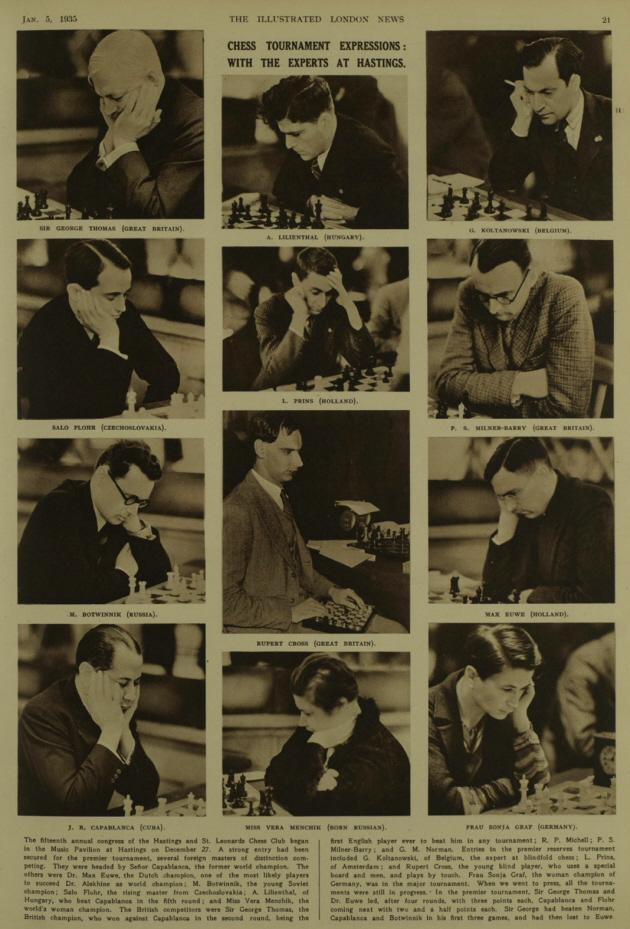
7490. More photographs from the Illustrated London News
Olimpiu G. Urcan has submitted a further series of photographs from the Illustrated London News:
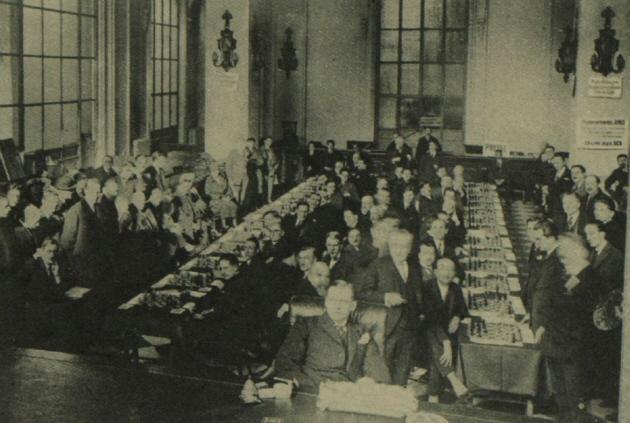
Alexander Alekhine (blindfold exhibition in Paris). 25 February 1925, page 205
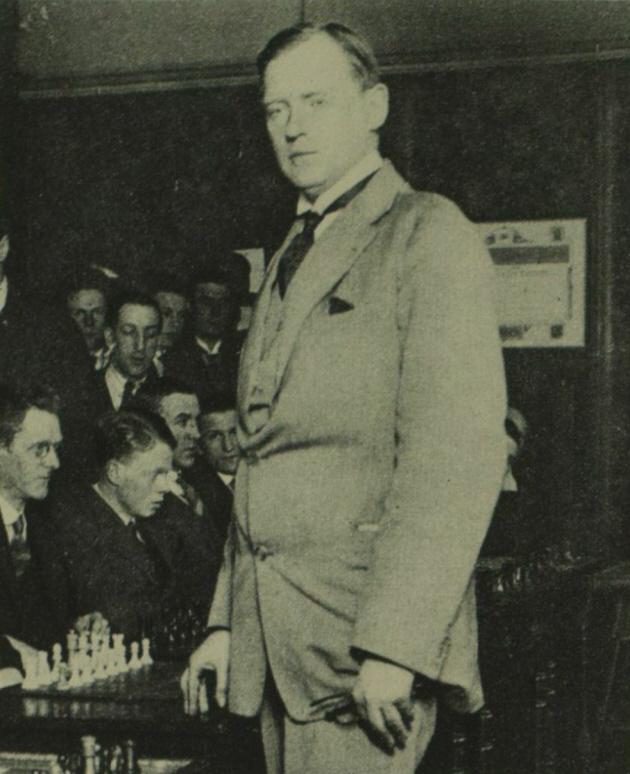
Alexander Alekhine. 10 December 1927, page 1064
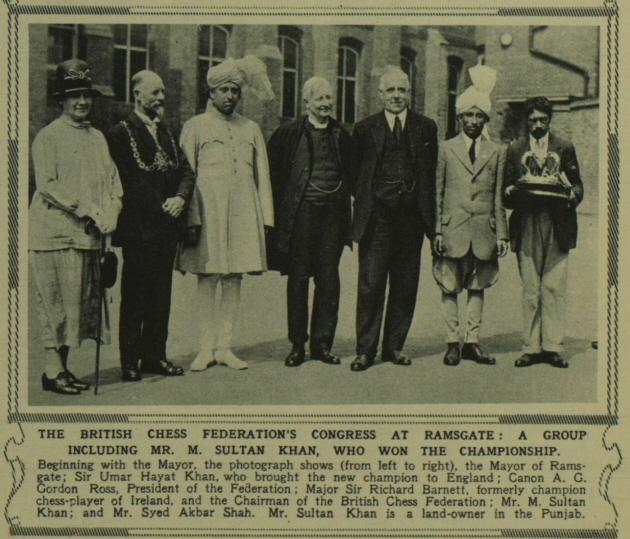
17 August 1929, page 293
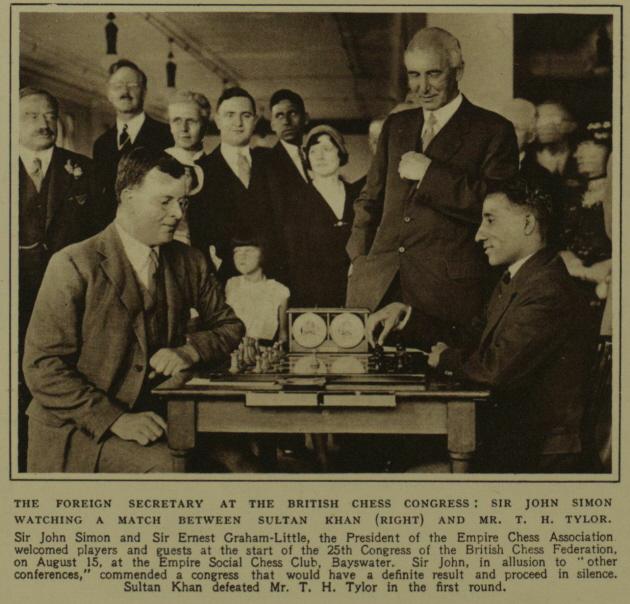
20 August 1932, page 264
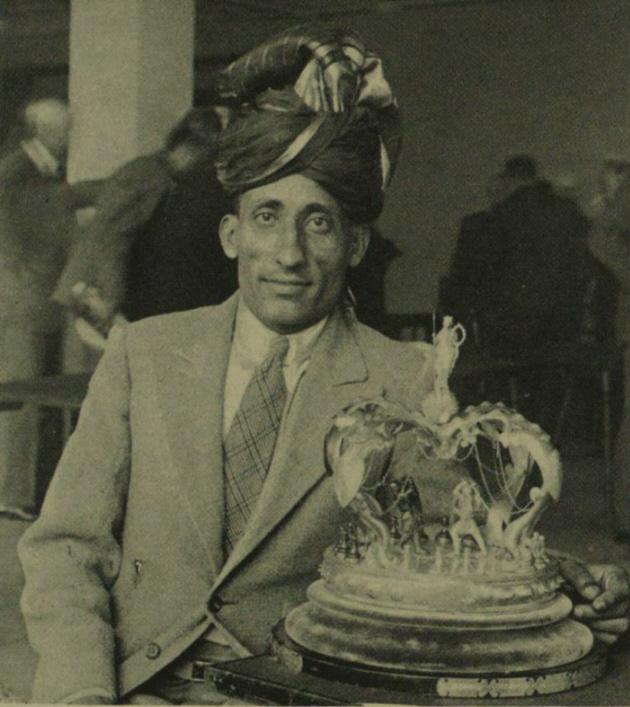
Sultan Khan with the British championship trophy. 3 September 1932, page 332
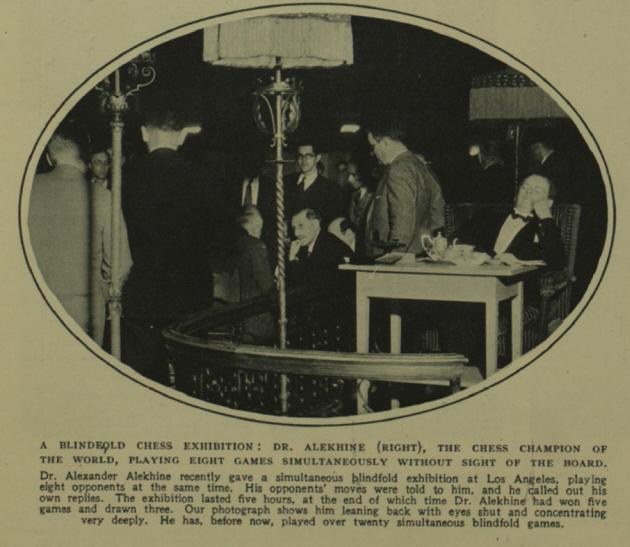
1 October 1932, page 498
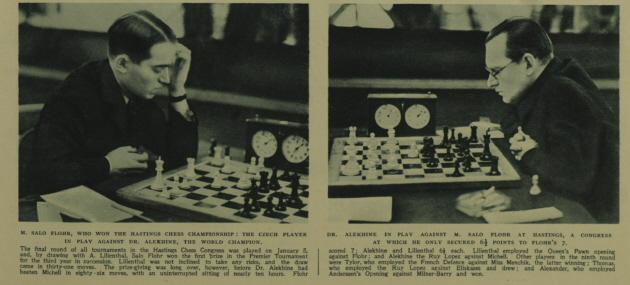
13 January 1934, page 67
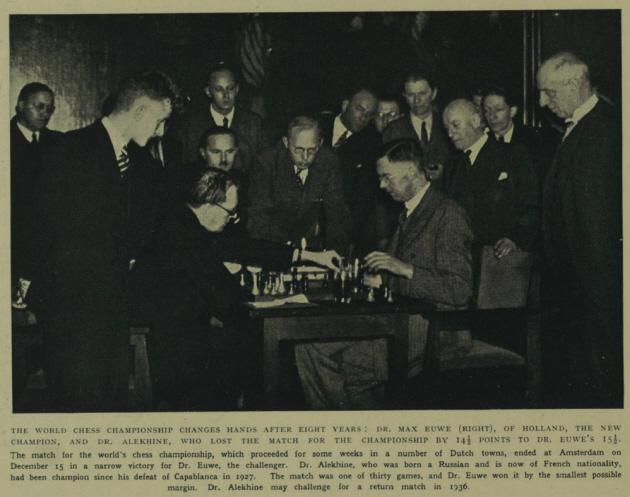
28 December 1935, page 1186
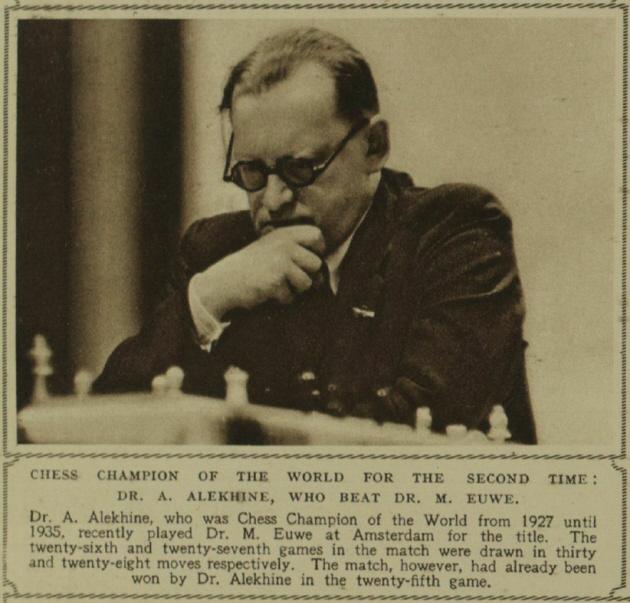
18 December 1937, page 1106
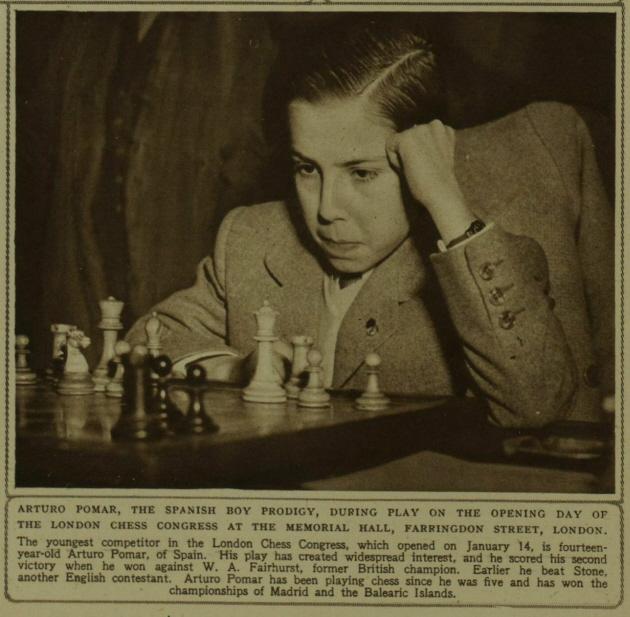
26 January 1946, page 102.
7491. Mitzi Mayfair
The dancer and actress Mitzi Mayfair (1914-76) was mentioned in C.N. 7076 (see also Chess and Hollywood), and she appeared with Héctor Rossetto in this photograph from page 31 of the October 1945 Chess Review:
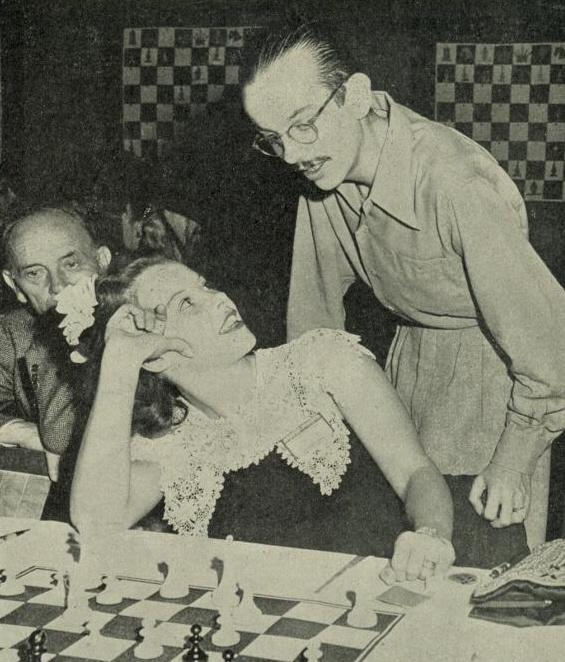
The magazine noted that she had participated in the women’s tournament in Hollywood under her married name, Mrs Charles Henderson.
Steven B. Dowd (Birmingham, AL, USA) adds that this biographical note was published on page 26 of Chess Review, November 1948:
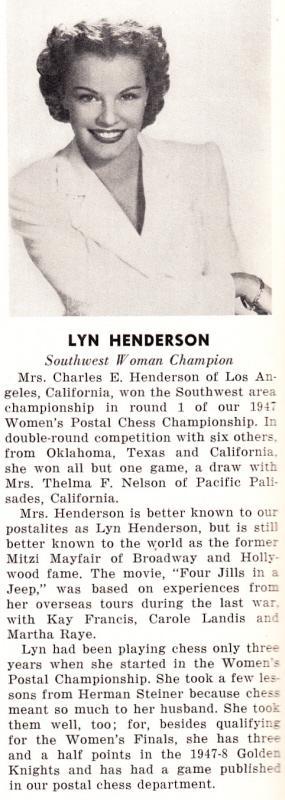
Our correspondent also points out that the game referred to was on the inside back cover of Chess Review, October 1947:
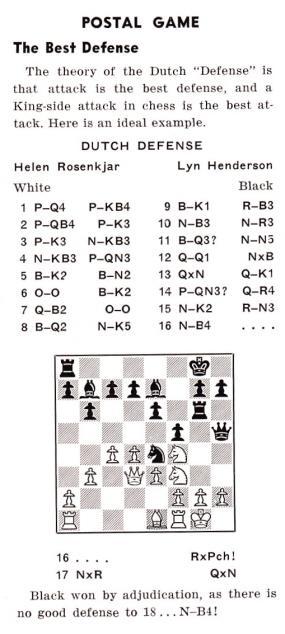
Helen Rosenkjar – Lyn Henderson
Correspondence game
Dutch Defence
1 d4 f5 2 c4 e6 3 e3 Nf6 4 Nf3 b6 5 Be2 Bb7 6 O-O Be7 7 Qc2 O-O 8 Bd2 Ne4 9 Be1 Rf6 10 Nc3 Na6 11 Bd3 Nb4 12 Qd1 Nxd3 13 Qxd3 Qe8 14 b3 Qh5 15 Ne2 Rg6 16 Nf4 Rxg2+ 17 Nxg2 Qxf3 and ‘Black won by adjudication’.
7492. Signed by Richard Nixon
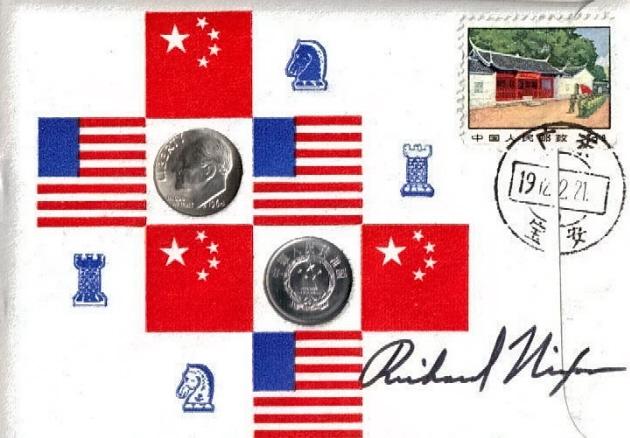
Ross Jackson (Raumati South, New Zealand) recently acquired this item, described as follows by the vendor:
‘Small envelope with Chinese and American flags in checkered pattern, flanked by Castle and Knight chess symbols. American dime and Chinese one-renminbi coin inset with die-cut peekaboo window, both coins dated 1964. This item is signed by Richard Nixon in the lower right corner and bears a postage stamp and processing mark, which is possibly only decorative. The envelope remains sealed with Nixon’s signature across the flap.’
7493. Thomas Hyde
On page 841 of A History of Chess (Oxford, 1913) H.J.R. Murray referred appreciatively to Thomas Hyde’s investigations into the origins of the game, whilst noting that Hyde was ‘no chessplayer himself’.
William Poole (Oxford, England) draws attention to an entry dated 17 June 1718 in the diaries of Thomas Hearne, as published on, for instance, page 408 of Reliquiae Hearnianae (Oxford, 1858):
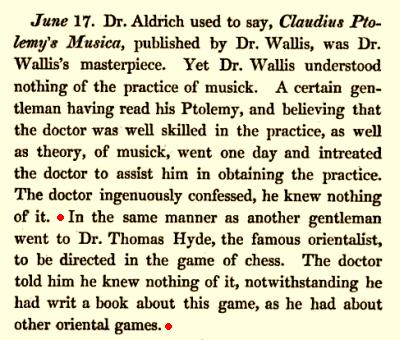
An English translation, with commentary, of Hyde’s De Ludis Orientalibus (Oxford, 1694) was published by Victor Keats under the title Chess Its Origin (Oxford, 1994).
7494. ‘All those books’
From page 139 of Chess Review, May 1963:
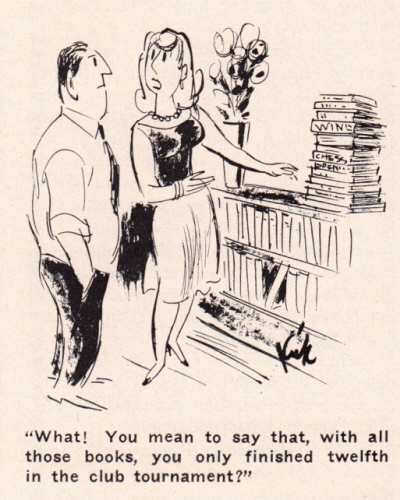
7495. Alekhine memorabilia
A chacun son héros – Alekhine, le virtuose des échecs by Guy Gignac (Montreal, 2011) has a rich selection of photographs, documents and information, sometimes presented with a lamentable indifference to attribution and sources.
7496. Capablanca at the Imperial Chess
Club
Olimpiu G. Urcan forwards this photograph from page 1037 of the Illustrated London News of 1 December 1928:
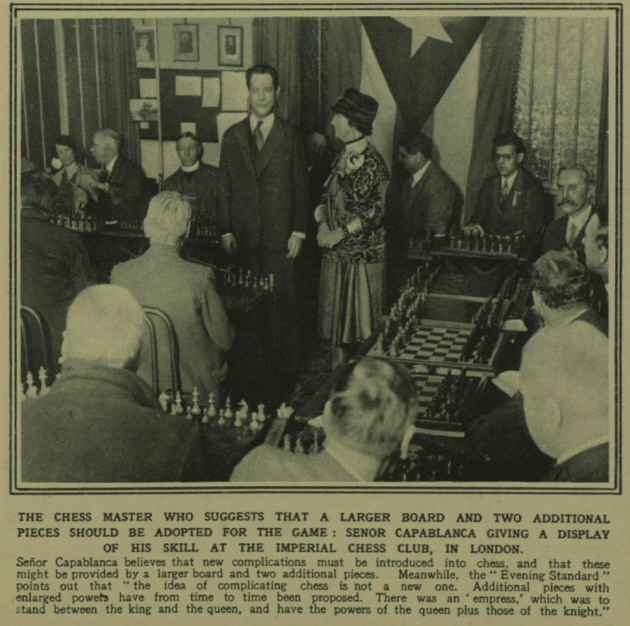
We add that the person standing next to Capablanca is Mrs Arthur Rawson, the President of the Imperial Chess Club. The following picture comes from opposite page 57 of the February 1928 BCM:
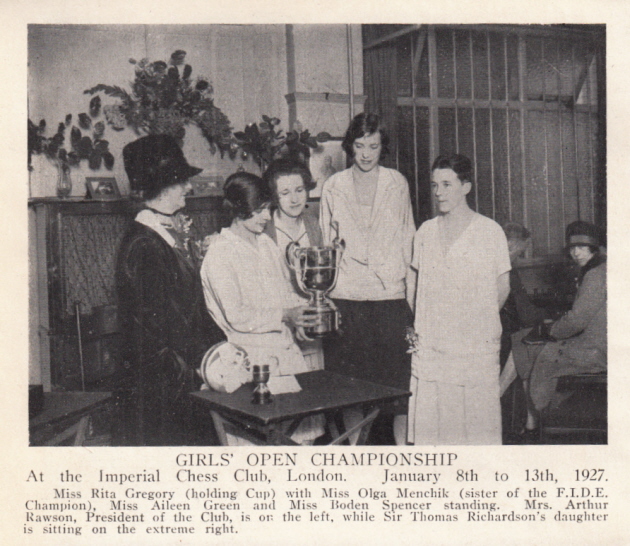
For an exchange of letters between Capablanca and Mrs
Rawson see page 247 of our book on the Cuban. The
ancestry.com website states that Ella Frances Rawson
died in Whissendine on 17 July 1942.
| First column | << previous | Archives [90] | next >> | Current column |
Copyright: Edward Winter. All rights reserved.
